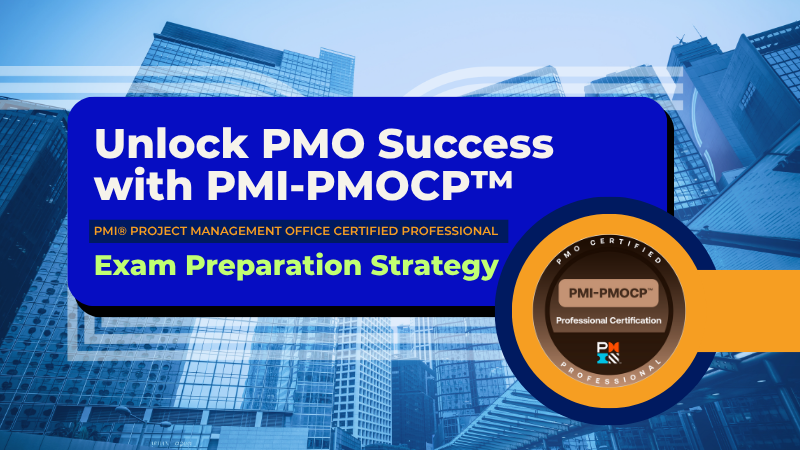
by DharamCW | Jul 24, 2025 | Leadership in Project Management, Portfolio Management, Program Management, Project Management, Project-Program-Portfolio Management Knowledge
Introduction
Project Management Offices (PMOs) are more than just administrative hubs in today’s busy business world. Businesses can adapt, provide value, and make wise decisions with the support of these strategic drives. As businesses look for professionals capable of spearheading this transformation, the PMI-PMOCP™ (PMO Certified Professional) has emerged as a highly regarded certification confirming both strategic insight and PMO leadership.
With the help of useful frameworks and leadership skills, PMI-PMI-PMOCP™ enables professionals to create, run, and develop PMOs that support organizational objectives. It positions certified leaders as important forces behind corporate transformation by signifying a change from traditional project oversight to strategic value delivery.
This article offers a detailed guide on obtaining the PMI-PMOCP™ certification, covering the exam layout, study schedule creation, leadership development, PMO capacity improvement, and finding resources and prep tools. It emphasizes the importance of developing leadership skills, improving PMO capacity with actual knowledge, and finding practical exam-day advice to maximize the certification’s impact on your career.
Unlocking career potential with PMI-PMOCP™
The growing focus on value-driven delivery and strategic alignment across businesses is changing the function of PMOs. Through specialised credentials like the PMI-PMOCP™, this shift has created a fantastic opportunity for people to progress in their careers. The certification attests to a deep understanding of PMO operations, governance frameworks, and business integration and is intended for PMO executives, team members, and portfolio professionals.
The PMI-PMOCP™ is a strategic facilitator for career progression that goes beyond a certification. It prepares professionals for positions influencing corporate decision-making rather than just operating coordination. With this certification, applicants can pursue senior roles that prioritize leadership and stakeholder engagement, such as Head of Strategic Initiatives, Enterprise PMO Manager, or PMO Director. Possessing the PMI-PMOCP™ boosts your reputation and demonstrates to potential employers that you are capable of starting, expanding, and optimizing PMOs for long-term impact in a global job market that is increasingly focused on measurable skills.
According to the Earning Power: Project Management Salary Survey—Twelfth Edition, only 61% of PMOs believe they are successful, and 93% of unbacked PMOs say their value is not understood by executives. These findings highlight the growing need for certified professionals who can lead strategic, value-driven PMOs.
Additionally, the certification promotes professional mobility across sectors and locations for those who want to lead change in complex settings. For seasoned professionals prepared to take on more senior leadership responsibilities, the PMI-PMOCP™ is a wise, forward-thinking investment in career development.
The Role of PMI-PMOCP™ in today’s evolving PMO landscape
The PMI‑PMOCP™ certification is essential for confirming the strategic abilities needed by modern businesses, as PMOs expand beyond their traditional administrative duties.
In a Broadcom survey, 96% of 501 multinational companies said they were becoming more reliant on PMOs to centralise project management and improve value delivery; 98% said they thought PMOs were critical, and 93% said they intended to grow their PMO operations. This modification emphasises the necessity of having skilled professionals lead these next-generation PMOs.
NTT DATA’s “Evolution of the PMO” report highlights how digitally empowered, agile PMOs are evolving into strategic value centres, leveraging analytics and artificial intelligence to improve productivity and decision-making. Because the PMI‑PMOCP™ evaluates all of these skills, these PMOs require leaders with expertise in governance maturity, digital tool execution, and integration with business strategy.
A great example of how they may increase their delivery flexibility is the PMO of Melbourne Airport, which used hybrid systems and became the only provider during COVID-19. By equipping them with the frameworks, stakeholder engagement techniques, and governance understanding required for PMOs in the digital era, certification equips PMO executives to spearhead such transformations.
PMI-PMOCP™ holders are prepared to guide companies through challenging transformation by collaborating closely with strategic portfolio and performance management methodologies. This ensures that PMO activities are not only monitored but also optimized for a company-wide impact.
Advancing from execution to strategy: A career shift enabled by PMI-PMOCP™
Building on this solid base, the PMI-PMOCP™ certification turns into a strong enabler for those trying to move from execution-centered jobs to strategic leadership posts. By arming PMO practitioners with the systems and competencies required to make significant decisions, it bridges the gap between operational delivery and corporate value realization. Experts who are certified manage portfolio priorities, align projects with corporate strategy, and assess results important to executive stakeholders. They are trained to handle tasks beyond the constraints of deadlines and scope. This change makes them as essential to corporate transformation by turning their function from task fulfillment to strategic advice.
In actuality, this change is quite apparent. After receiving PMI-PMOCP™, many professionals formerly in charge of project coordination have moved into roles such as Strategic Realization Office Lead, Director of Enterprise PMO, or Head of Delivery Governance. These positions call for more than just process knowledge; rather, the capacity to influence, negotiate, and generate results consistent with company objectives is required.
PMI-PMOCP™,’s focus on strategy alignment, advantage realization, and maturity models makes this career leap possible. For those seeking substantial expansion, it provides a clear path to influence portfolio-level decisions and lead the business from the front, making the shift from project manager to strategic leader a reality.
A closer look at the exam structure and core domains
The PMI-PMI-PMOCP™ exam is developed to evaluate both theoretical knowledge and practical capabilities since PMO leadership necessitates the development of real-world competencies. It assesses a candidate’s capacity to consciously plan, create, carry out, and improve PMO operations in a range of organizational contexts. Focused research necessitates domain and structural knowledge for subject matter experts.

Learn the PMI-PMOCP exam structure: 120 questions, 165-minute duration, online & in-center availability, and psychometric scoring. Prepare with confidence.
Key Exam Structure:
- Format: 120 multiple-choice questions (100 scored + 20 unscored pretest items)
- Duration: 165 minutes (2 hours 45 minutes), with one optional 10-minute break
- Mode: Available both online (proctored) and at exam centers
- Scoring: Pass/fail based on psychometric analysis (no fixed cutoff score)
Core Exam Domains and weightage:
- Organizational Development and Alignment (16%): Focuses on building organizational project management maturity and capability.
- PMO Strategic Elements (18%): Covers PMO vision, mandate, governance, and stakeholder engagement.
- PMO Design and Structuring (18%): Examines service design, customer-centricity, and value proposition.
- PMO Operation and Performance (15%): Assesses service delivery, resource management, and onboarding processes.
- PMO Enhancement and Effectiveness (18%): Emphasizes performance measurement, maturity models, and continuous improvement.
- People (15%): Evaluates leadership, interpersonal skills, and strategic thinking.

Master the 6 core domains of the PMI-PMOCP exam—get familiar with what matters most and where to focus your preparation.
Successful completion of the exam and practical implementation of ideas in real-world PMO scenarios are prerequisites for a thorough comprehension of these fields.
Designing a Smart Study Plan using the Exam Content Outline (ECO)
Having a well-organised and targeted study plan is essential for passing the PMI-PMOCPTM test. You may be sure that your preparation aligns with the fundamental abilities required of high-performing PMO staff by using the Exam Content Outline (ECO). Because it provides detailed instructions on domains, tasks, and enablers, the ECO is the most reliable place to start when creating your exam strategy.

Maximize your PMI-PMOCP prep with this 6-step study plan—prioritize domain weights, apply case-based learning, and grow strategic PMO skills.
Steps to create an efficient study schedule:
- Get to know the Domain Weights: Based on the domain percentage (e.g., PMO Strategic Elements and PMO Design each carry 18%), give study time top focus.
- Divide Projects and Enablers: Translate every domain into actual situations to internalize ideas and gauge practical understanding.
- Mapping Experience to Competencies: Find locations where your hands-on PMO knowledge complements or falls short of ECO job coverage.
- Assign objectives for weekly study: Assign particular domains per week using a calendar, therefore balancing theory review, case analysis, and practical experience.
- Use Case-Based Learning: Deepen your awareness of stakeholder engagement, service design, and performance measures by using case studies and sample scenarios.
- Regular Reviews and Revisions: Set weekly reviews and strengthen underperforming areas found through self-evaluations or mock examinations.
Keeping up with the ECO helps you concentrate on your studies and learning PMO leadership skills that are both career-oriented and relevant to exams.
Growing your strategic thinking and leadership skills
The ECO’s study plan equips candidates with leadership and other critical abilities that go beyond test preparation. The PMI-PMOCP™ certification aids in the development of strategic thinking and leadership skills that are necessary for directing organisational effect through the PMO.

Grow your PMO leadership impact with PMI-PMOCP™ – from strategic alignment and governance to stakeholder influence and executive presence.
The PMOCP™ process plays a vital role in supporting leadership and strategic development, like:
- Improves strategic alignment: Enhances your capacity to align portfolio and program results with organizational objectives and long-term vision.
- Develops stakeholder engagement capabilities:Builds stakeholder engagement skills by enhancing communication, negotiating, and relationship-building across executive, functional, and delivery teams.
- Fosters systems thinking: Encourages systems thinking by showing you how to evaluate linkages across projects and portfolios to provide a more expansive viewpoint.
- Enhancing governance and risk leadership: Arms you with instruments to proactively handle strategic risks and set up efficient decision-making systems.
- Supports data-informed decision-making: Encourages the use of key performance indicators and maturity models to drive ongoing improvement.
- Builds executive-level presence:Helps you portray PMO value in business terms and direct influence at the leadership table, establishing an executive-level presence.
Professionals grow into forward-thinking leaders who help the PMO serve as a catalyst for strategy execution and corporate transformation via the PMOCP™ certification process.
Strengthening your PMO capabilities with practical knowledge
Building realistic, hands-on skills is vital as PMOs become strategic allies inside companies. Meant to improve not only theoretical understanding but also the practical application of PMO ideas across a range of business scenarios, the PMI-PMOCP™ certification is also meant to help. By means of its six key domains, the certification assists professionals in enhancing their capacity to plan and run PMOs that match the objectives of the company. Candidates acquire knowledge on how to establish performance measures that show quantifiable impact, execute governance systems, and define distinct PMO service offerings.
Moreover, stressed in the program stresses capacity building via maturity assessments, feedback systems, and continuous improvement approaches. PMO leaders may routinely evaluate success and change their services to meet changing corporate demands using these tools. Furthermore, the certification strengthens core talents in benefit realization, stakeholder management, and resource planning. Professionals become better prepared to head high-performing PMOs supporting both agile and traditional delivery environments by means of this understanding.
The pragmatic frameworks discussed in the PMI-PMOCP™ program help you to develop fit-for-purpose ideas, whether you are building a new PMO or improving one already in place. Maintaining long-term value and positioning the PMO as a reliable strategic player in the company depends on this capacity.
Tools, resources, and prep courses to accelerate your growth
It takes more than just reading to get ready for the PMI-PMOCP™ certification. A strategic plan needs to be backed up by relevant materials, instructional materials, and systematic learning in order to be successful. For PMO experts looking to increase their knowledge and improve their test preparation, using targeted information is essential.
Your preparation route is supported by a number of high-quality materials. These materials make it possible to use concepts in real-world PMO scenarios in addition to passing the exam.
Suggested learning resources and tools include:

Ace the PMI-PMOCP exam with the right resources: ECO, case studies, question banks, and memory aids like flashcards and mind maps.
- Exam Content Outline (ECO): The ECO serves as the foundation for all study plans. It divides areas, chores, and facilitators that you have to learn.
- Case Studies and Real-World Scenarios: Connect theory to real-world PMO decision-making by using industry case studies.
- Practice Exams and Question Banks: Regular exams help expose areas of deficiency and prepare you more effectively for exams using practice exams and question banks.
- Flashcards and Mind Maps: Excellent for remembering concepts, models, and vocabulary via flashcards and Mind Maps.
PMO Capability Maturity Models and Templates: Help you to grasp strategic alignment and operational excellence.
A selection of the best preparation programs:
• Instructor-led boot camps focused on domain-wise learning
• On-demand video lectures enabling flexible study
• Peer discussion groups and study cohorts for collaborative learning
Exploring thought leadership blogs, PMO podcasts, and LinkedIn learning spaces helps bring in wider perspectives and expert insights. The newly launched PMOCP4U LinkedIn group offers a dedicated space for PMO professionals and PMI-PMOCP™ aspirants to connect, exchange resources, and grow together. Building lasting capability in PMO leadership and true exam confidence, depends on combining structured preparation with practical, real-world dialogue
Exam-day confidence: Tips to manage time and approach questions
More than technical ability is needed for success on the day of the exams. It calls for confidence, concentration, and a well-practiced approach. The PMI-PMOCP™ exam seeks to assess your capacity to apply PMO ideas in realistic and sometimes difficult situations as well as your knowledge of PMO concepts.
Time management and a bold approach to the exam are crucial:

Maximize your exam success with these 5 time-tested PMI-PMOCP strategies—clarity, direction, pacing, and smart elimination.
- Start your day with clarity: If you are taking the exam online, arrive early for check-in or system testing, get a full night’s sleep, and eat properly.
- Read the directions thoroughly: During the first several minutes, get acquainted with the navigation and structure of the questions.
- Adopt a three-round approach: First, respond to questions you are certain of. Second, try rather challenging ones. Last, go back to any questions marked or time-consuming.
- Track your time without pressure:Target to finish the first 60 questions in around 80 minutes, allowing adequate time for the other parts, so monitor your time without pressure.
- Employ elimination techniques: Especially in scenario-based problems, eliminate wrong possibilities to enhance accuracy. Wise optional break: Use this time to refocus and reset for the second half of the exam.
Supported by thorough preparation, a calm and organized approach will enable you to negotiate the exam with confidence and clarity.
From certification to career growth: Making the most of PMI-PMOCP™
Getting the PMI‑PMOCP™ certification is just the first step; true professional development results from your use of it. According to the Master of Project Academy’s recent data, 35. 8% of project-related certified professionals saw a 10% plus salary increase after getting their credentials, and 41. 1% found promotions or new positions. This implies that rather than only validating abilities, certification results in noticeable progress.

PMI-PMOCP isn’t just a certification—it’s your launchpad to leadership, strategic impact, and better pay.
In your role as a PMO specialist, you aim to utilize your qualifications for actual career advancement:
- Highlight measurable results:Show projects where your PMO techniques enhanced performance, governance, or stakeholder satisfaction to position yourself as a business-value driver. Highlight measurable outcomes.
- Aim for strategic PMO roles: Many PMOCP™ holders assume leadership positions like PMO Director, Portfolio Governance Manager, or Head of Delivery Strategy, roles that call for the precise skills indicated by the certification.
- Leverage in job negotiations: Negotiate compensation, role level, or responsibility using achievements linked to credentials. Usually, certified professionals have greater initial pay.
Organizations are also aggressively seeking PMO-certified specialists to bridge the gap between strategy and implementation. Certification like PMOCP™ have genuine market relevance as PMOs more and more promote hybrid delivery, data-driven decision-making, and digital transformation. You must possess not only process-oriented skills but also strategic thinking, data literacy, and an agile mindset.
Action plan for post-certification success:

PMOCP™ is just the beginning. These 4 post-certification strategies can define your leadership path and strategic influence.
- Refresh your brand: Build your brand identity by using PMOCP™ on LinkedIn, your resume, and profiles while sharing success stories related to corporate influence.
- Communicate with PMO circle: Take part in PMO-oriented conversations, podcasts & webinars, and more in person to network and share ideas and raise awareness.
- Pursue high-impact internal projects:To show strategic leadership, volunteer for internal cross-functional or digital project programs inside your company.
- Seek formal or informal mentorship:Ask senior PMO leaders for advice on managing strategic roles or growing PMO capacity and look for formal or informal mentorship.
You are not just confirming your abilities by deftly matching your certified skills to organizational needs and highlighting your impact, but also hastening a deliberate move into senior PMO leadership. The PMI PMOCP™ can be the catalyst that changes your career path, thereby converting a certification into permanent professional development.
Conclusion
The PMI-PMOCP™ certification is more than simply a scholastic achievement in today’s evolving PMO landscape; it is a strategic gateway to leadership and professional advancement. From the beginning of the planning process, professionals gain insight on how to maximize stakeholder impact, align PMO duties with company vision, and provide demonstrable value. Through a well-organized study plan, a deep understanding of the Exam Content Outline (ECO), and an emphasis on real-world application, candidates get a mix of knowledge and leadership abilities that are immediately applicable in the workplace.
When experts look into the certification, they find several important questions, such as:
- How does PMI-PMOCP™ distinguish itself from other project management certifications?
- Will this certification enable me to advance to a strategic or leadership position?
- How may I show my employer the advantages of certification?
- Do long-term professional benefits outweigh the time and money invested?
- How can I apply and maintain my knowledge if I pass the examination?
These questions are not only genuine, but they also provide insights from professionals who are about to make important advancements. The answer depends on how the certification is used.
I had the opportunity to speak with PMI’s Kim Marcelliano about the strategic relevance of the PMI-PMOCP™ certification.
Upcoming PMI-PMOCP™ programs led by me will offer a structured path for professionals looking to deepen their PMO capabilities and earn this strategic credential. I’m excited to support and share these initiatives as they unfold.
Upcoming PMI-PMOCP Exam Prep Training 2025:
Online PMI-PMOCP Bootcamp:
- 27–28 September, 9am-5pm, CDT | Link: https://bit.ly/4mrfBHo
- 7-8 November, 7 am – 3 pm CST | Link: https://bit.ly/3FRlr4i
- 15 – 16 November, 9am-5pm, CST | Link: https://bit.ly/4jbZGcY
Direct PMI-PMOCP Bootcamp, Dallas, USA :
- 17-18 November, 9am-5pm, CST | Link: https://bit.ly/3Zqlgn2
- 13-14 December, 9am-5pm CST | Link: https://bit.ly/4drorAA
When used strategically, PMI-PMOCP™ not only validates your expertise but also positions you to drive change, provide value, and shape your company’s future through a productive PMO.
#PMIPMOCP #PMOCertification #PMOLeadership #ProjectManagement #StrategicLeadership #PMOCareer #DharamSingh #vCareProjectManagement #PMIATP #PMOCPExamPrep #PortfolioGovernance #PMOTransformation #ExamSuccess #PMOStudyTools #PMOCPJourney
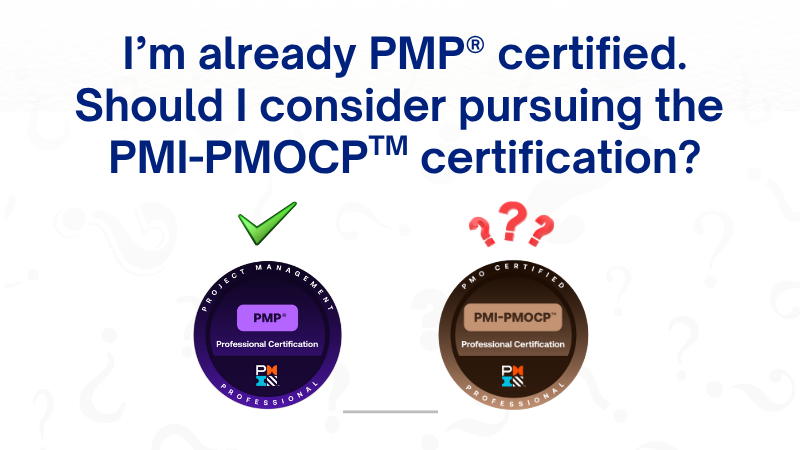
by DharamCW | Jul 22, 2025 | Leadership in Project Management, Project-Program-Portfolio Management Knowledge
Episode 1: Should You Pursue PMI-PMOCP After PMP? | PMO Leadership, Certification Benefits & Career Growth | Kim Marcelliano | Dharam Singh | vCare PMI PMOCP Webinar Insights Podcast Series: PMI-PMOCP Certification | PMO Leadership, Exam Guide, ECO & Career Growth
Guest: Kim Marcelliano, Senior Product Manager at PMI Host: Dharam Singh, Leading PMP, PgMP & PfMP Mentor
Question: I’m already PMP® certified. Should I consider pursuing the PMI-PMOCP™ certification?
Description: In this insightful episode, Kim Marcelliano answers a question many PMP® holders are asking: is the PMI-PMOCP™ credential the right next step? Kim explains how the PMP® focuses on managing individual projects, while PMI-PMOCP™ equips professionals to lead and influence the PMO at a strategic level. As organizations increasingly rely on PMOs to drive value and transformation, project managers are being called upon to contribute beyond task execution. For PMP® certified professionals ready to expand their influence and visibility within their organizations, PMI-PMOCP™ offers a complementary pathway to demonstrate leadership in driving enterprise-wide project success. 🎯 Key Takeaways:
- PMP and PMI-PMOCP serve distinct but complementary roles
- PMOCP is ideal for those involved in PMO leadership or aspiring to it
- PMP® is about managing projects; PMOCP is about elevating PMO strategy
- Certification validates your ability to align projects with organizational value
- PMOCP helps PMP® holders transition from project delivery to strategic impact
About Our Guest: Kim Marcelliano is a dynamic Senior Product Manager at PMI with over a decade of experience in managing global certification products and online learning strategies. Known for her entrepreneurial mindset and deep expertise in cross-functional leadership, Kim brings a blend of market intelligence, emotional intelligence, and innovation to every product she shapes. She is also a Certified EQ Coach and a passionate advocate for personal growth and leadership. About the Host: Dharam Singh is a globally recognized PMP®, PgMP®, and PfMP® mentor and CEO of vCare Project Management. With 30 years of leadership experience across industries and more than 576+ PgMP , 181 PfMP and 1000s of PMP mentees globally, he is an influential voice in the project management community and a tireless advocate for career advancement through PMI certifications.
⏱ Time Stamps:
00:00 – Introduction
00:10 – I’m already PMP certified. Should I pursue PMI-PMOCP?
00:40 – PMP vs PMI-PMOCP: Different roles, complementary value
01:28 – How PMI-PMOCP Certification going to help me?
Connect With our Speakers:
1. Kim Marcelliano:  / kmarcelliano
/ kmarcelliano
2. Dharam Singh:  / dharamsingh
/ dharamsingh
Upcoming PMI-PMOCP Exam Prep Training 2025:
Online PMI-PMOCP Bootcamp:
1. 27–28 September, 9am-5pm, CDT | Link: https://bit.ly/4mrfBHo
2. 7-8 November, 7 am – 3 pm CST | Link: https://bit.ly/3FRlr4i
3. 15 – 16 November, 9am-5pm, CST | Link: https://bit.ly/4jbZGcY
Direct PMI-PMOCP Bootcamp, Dallas, USA :
1. 17-18 November, 9am-5pm, CST | Link: https://bit.ly/3Zqlgn2
2. 13-14 December, 9am-5pm CST | Link: https://bit.ly/4drorAA
Contact Us: Call us: +1 972 292 7588 / +1 650 283 0123 (U.S.)
Free Consultation: Book a free 15-minute session with Dharam Singh, http://talktodharam.com
Subscribe for More: PgMP & PfMP Success Stories https://bit.ly/2YF0wJl
Dharam Singh Podcasts and Interviews: https://bit.ly/2NDY8wd
Direct Bootcamps:
PMOCP: https://bit.ly/4jnDUmY
Online Programs
PMOCP: https://bit.ly/4dKY35f
LinkedIn Study Groups PMOCP4U:  / 14744039
/ 14744039
#PMIPMOCP #PMPtoPMOCP #PMOCertification #ProjectManagement #StrategicLeadership #CareerGrowth #PMOLeadership #vCareProjectManagement #DharamSingh #KimMarcelliano #PMICertifications #PMPJourney #PMOCareerPath #PMO #PMI #LeadershipCertification #PMOCPWebinar #PMPVsPMOCP #PMIATP
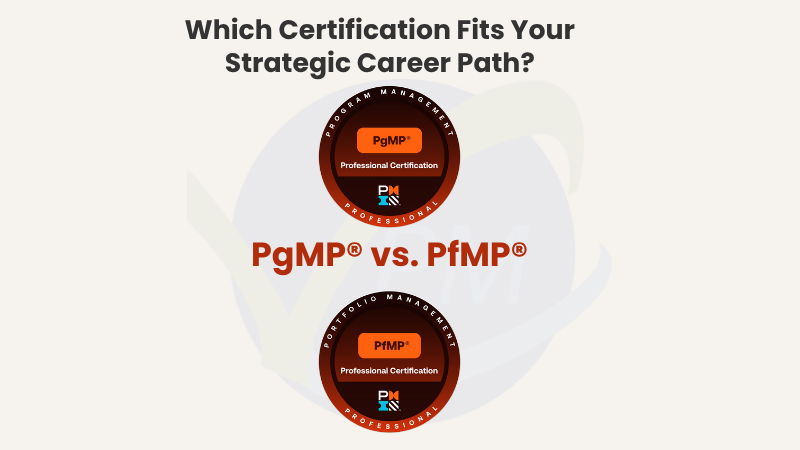
by DharamCW | Jul 12, 2025 | Leadership in Project Management, Portfolio Management, Program Management, Project Management, Project-Program-Portfolio Management Knowledge
PgMP vs PfMP – Which Certification Fits Your Strategic Career Path?
In today’s rapidly evolving business landscape, the ability to lead with strategy, agility, and value alignment is no longer optional. It’s essential. If you’re navigating the path between program management and portfolio leadership, understanding the core distinctions between PgMP and PfMP is critical.
This side-by-side comparison is built directly from the official PMI Examination Content Outlines. It will help you assess:
– The Primary Purpose of each certification
– The Strategic Function it enables
– The Key Domains you’ll master
– The Core Activities you’ll drive
– And ultimately, who it’s Ideal For
Having sucessfully mentored over 576+ PgMPs and 180+ PfMPs globally, I’ve seen how the right certification choice accelerates leadership journeys.
– No fluff. No assumptions. Just clarity based on facts.
– Take a closer look at the visual and tell me in the comments:
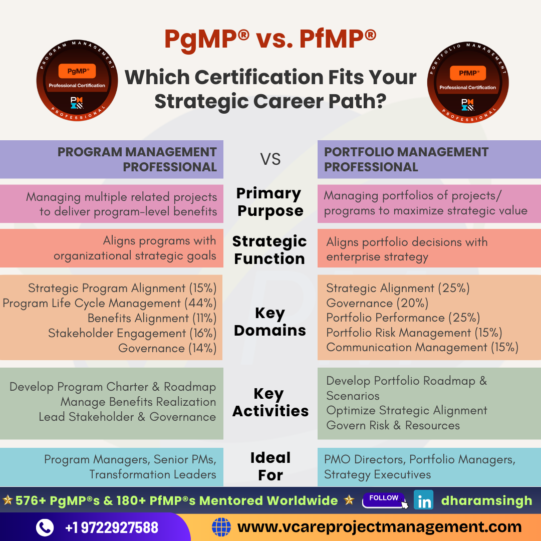
Confused between PgMP and PfMP? See how each certification supports distinct strategic roles—and choose the right path for your leadership journey.
Which path reflects your next leadership move – PgMP or PfMP?
If you’re still unsure which one best fits your goals, book a personalized, obligation-free consultation session with me at http://talktodharam.com
📌 View our upcoming PgMP Programs
Online Training → http://bit.ly/2oBKQXQ
Direct Training → http://bit.ly/2oCfpg0
📌 View our upcoming PfMP Programs
Online Training → http://bit.ly/39jOZSf
Direct Training → http://bit.ly/38er2M3
Subscribe for Stories & Insights:
Success Stories & Q&A → https://bit.ly/2YF0wJl
Podcasts & Interviews → https://bit.ly/2NDY8wd
#PgMP #PfMP #PMICertifications #ProgramManagement #PortfolioManagement #StrategicLeadership #ProjectLeadership #CareerGrowth #PMO #BenefitsRealization #vCareProjectManagement #DharamSingh #ProjectMentoring #LeadershipDevelopment #PgMPvsPfMP #PMI #ProjectSuccess #PfMPJourney #PgMPCertification #DecisionMaking
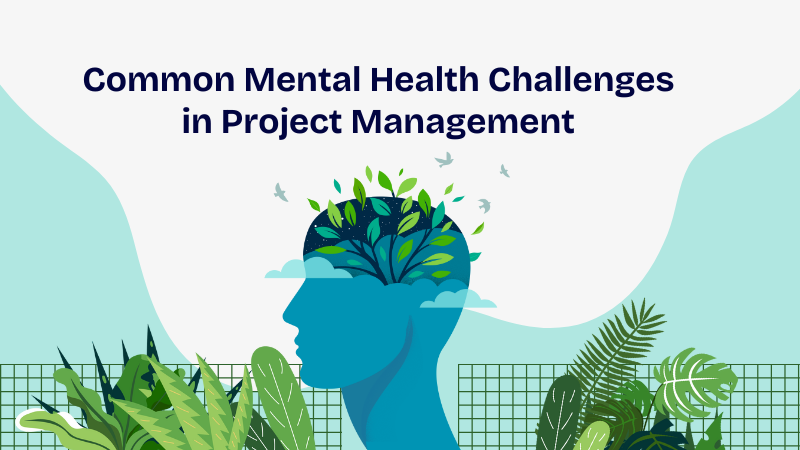
by DharamCW | Jun 30, 2025 | General, Project-Program-Portfolio Management Knowledge
🔵 Mental Health in Project Management: A Conversation We Must Have 🔵
Project managers are trained to deliver results, but what happens when the pressure becomes too much to bear?
In my 30+ years of mentoring, I’ve seen even the most capable professionals silently battle stress, burnout, and mental health challenges. It’s time we open up the conversation – because behind every successful project is a human being managing emotions, expectations, and exhaustion.
Here are 8 common mental health challenges faced by project professionals:
-> Stress
Tight deadlines, pressure, job insecurity, long hours, and heavy workloads are key causes of workplace stress.
-> Insufficient Assistance for Workers
Lack of support fuels these problems. Encouraging openness and honest dialogue boosts employee well-being.
-> Burnout
Burnout is common in many careers, marked by low energy, frustration, and dissatisfaction with work goals.
-> Anxiety
Workplace stress can lead to anxiety, often showing as social discomfort, avoidance, or conflict with coworkers.
-> Insufficient Leadership or Clarity
Poor role clarity and weak communication create a stressful work environment.
-> OCD
OCD causes unwanted thoughts and behaviors like over-checking or task delays, leading to stress at work.
-> Depression
It can be triggered by home problems, stress, and feelings of incompetence or insignificance.
-> Substance Use Disorder
Work stress can lead to substance use, with alcohol, marijuana, and painkillers being commonly abused.
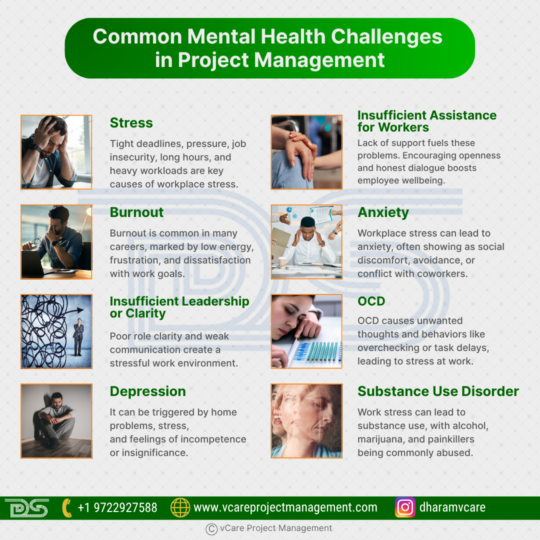
Project success shouldn’t come at the cost of mental health. Let’s talk about stress, burnout, and wellness in project leadership.
👉 These are real issues. Let’s not pretend otherwise.
🔁 Save & Share this if it resonates.
💬 What mental health challenges do you or your team face in high-pressure project environments?
Let’s open up – your voice could help someone else find theirs.
Free Consultation (Career, PMI Certifications):
Book a free 15-minute session with me, http://talktodharam.com
Subscribe for More:
Certification Success Stories https://bit.ly/2YF0wJl
My Podcasts and Interviews: https://bit.ly/2NDY8wd
Contact Us:
Call us: +1 9722927588 / +1 6502830123
#MentalHealthAwareness #ProjectManagement #BurnoutPrevention #WorkplaceStress #PMOLife #DharamSingh #vCareProjectManagement #LeadershipWellbeing #ProjectManagerSupport #PMICommunity #StressManagement #WorkplaceMentalHealth #AnxietyRelief #TeamWellbeing #PortfolioLeadership #ProgramManagement #PfMP #PgMP #PMP #PMO
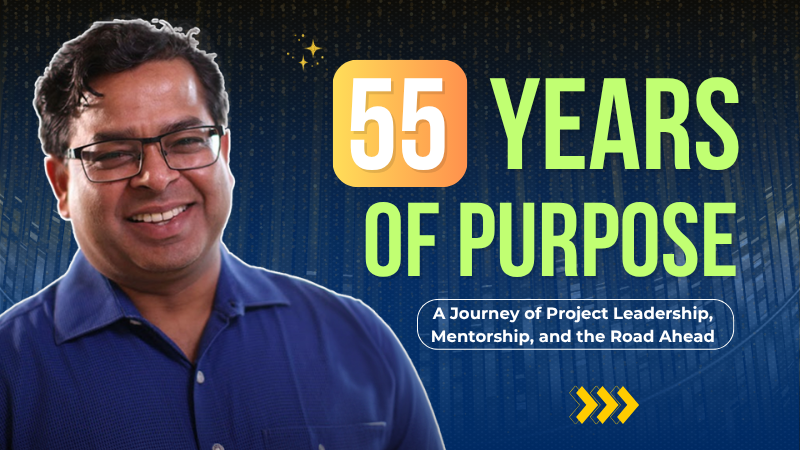
by DharamCW | Jun 20, 2025 | Leadership in Project Management, Portfolio Management, Program Management, Project Management, Project-Program-Portfolio Management Knowledge
Turning 55 makes me reflect on a journey built not just on time, but on projects, people, and a purpose that has guided me throughout. From a hands-on practitioner to a worldwide mentor directing professionals in navigating their paths in project leadership, this has been a learning-based journey for me.
“A leader is one who knows the way goes the way and shows the way.” – John C. Maxwell
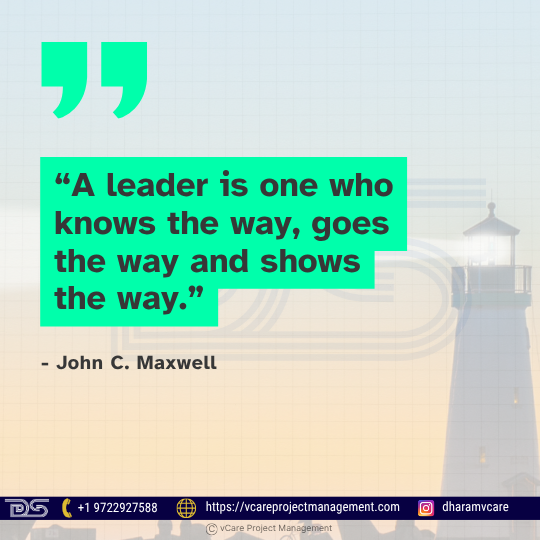
“Turning 55 reminds me—great leadership is about knowing the way, going the way, and showing the way.”
As the field of project management is evolving rapidly, bringing both complex challenges and exciting opportunities. Professionals often begin their journey with foundational credentials such as CAPM®, PMI Project Management Ready™, and PMI Kickoff™, which provide a solid base for advanced certifications like PMP®. As they grow in expertise and responsibility, many pursue specialized credentials such as PgMP® for program management and PfMP® for strategic portfolio management, emphasizing leadership, strategic thinking, and technical proficiency.
To further strengthen capabilities in PMO management and organizational alignment, PMI has recently launched the PMO Certified Professional (PMOCP)™. Collectively, these certifications offer a structured pathway for developing resilient, future-ready leaders equipped to navigate today’s dynamic project landscape.
Reflecting at 55: A Journey Built on Projects, People, and Purpose
I still find myself thinking about some basic concerns even after all these years of project, program, and portfolio management experience. These are not merely questions; rather, they are reflective thoughts that help me stay grounded, receptive to ongoing learning, and in line with the dynamic nature of our line of work. They remind us that no matter how far we’ve come, growth is an ongoing process. These important questions keep coming to mind:
1. How do I stay truly relevant in today’s fast-changing project world?
2. What really makes a mentor different from a practitioner in project leadership?
3. Can a career build on purpose last longer than one focused only on results?
4. What kind of mind-set does someone need to succeed in earning PgMP® or PfMP® certification?
5. How do I keep growing when the industry, tools, and expectations are always evolving?
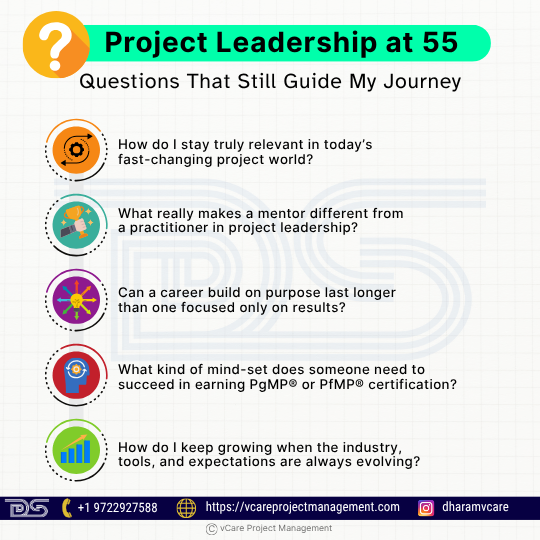
At 55, Dharam Singh reflects on the timeless questions that continue to shape great project leaders and mentors.
These questions shape the way I lead and mentor. They influence how I train, how I support aspirants, and how I walk alongside them on their certification journey. I believe these are not just personal reflections, but essential questions that every committed project leader must explore as they progress in their professional path.
From Practitioner to Global Mentor: My Evolution in Project Leadership
When I started my journey in project management, my focus was on project delivery. I concentrated on meeting deadlines, achieving goals, and satisfying stakeholders. Over time, as I led diverse teams and handled complex programs across sectors, my perspective began to shift. I started to value the power of strategic alignment and the human side of leadership. One of my most meaningful moments came when a former trainee told me that earning their PgMP® changed their entire career path. That made me realize mentorship was not just support, it was impact.
Becoming a global mentor was never part of a grand plan. It happened as I shared lessons, simplified complex concepts, and helped others unlock their potential. Today, I guide aspirants not only through certification paths but through mind-set transformation. I remind them that leadership is not about control, but about clarity, consistency, and contributing to the growth of others.
PgMP® and PfMP®: More Relevant Than Ever in Today’s Project Economy
Certifications like PgMP® and PfMP® have become increasingly important in today’s dynamic project environment. They not only validate advanced project leadership but also represent a professional’s commitment to driving impactful change in an innovation-driven world. These certifications empower professionals with strategic thinking, cross-functional leadership, and the ability to deliver results aligned with organizational goals.
PgMP® – Program Management Professional
The PgMP® credential is tailored for professionals managing multiple, related projects and achieving strategic objectives. It reflects leadership at a higher level, beyond individual project delivery.
Key aspects are:
• It focuses on managing complex programs and aligning them with strategic goals.
• It emphasizes benefits realization and stakeholder alignment.
• PgMP® is ideal for experienced project managers ready to scale up to program leadership.
Global Impact of vCare Project Management in PgMP® certification are:
1. North America
• United States: 11.2%
• Canada: 9.7%
• Mexico: 12.0%
2. Asia & Middle East
• India: 14.5%
• Saudi Arabia: 5.5%
• United Arab Emirates: 13.4%
• Singapore: 14.3%
• Malaysia: 26.0%
• Kuwait: 7.7%
3. Oceania
• Australia: 35.0%
• New Zealand: 35.0%
4. Europe
• Germany: 13.75%
• Italy: 17.2%
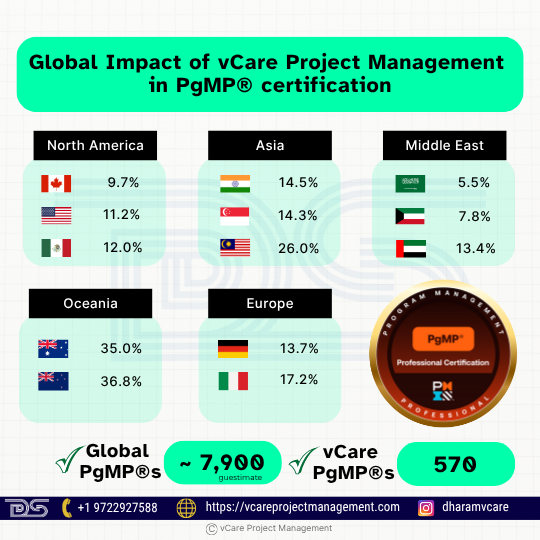
From practitioner to global mentor—Dharam Singh reflects on a leadership journey rooted in purpose and impact.
PfMP® – Portfolio Management Professional
The PfMP® credential is designed for senior professionals who manage portfolios of programs and projects aligned with strategic business objectives.
Key Highlights:
• It focuses on portfolio strategy, governance, performance, and risk management.
• It equips leaders to prioritize initiatives and optimize investments.
• It is ideal for executives and portfolio managers driving organizational value.
Global Impact of vCare Project Management in PfMP®:
1. North America
• United States: 10.0%
• Canada: 12.0%
2. Asia & Middle East
• Saudi Arabia: 3.4%
• India: 6.0%
• United Arab Emirates: 8.8%
• Qatar: 23.8%
• China, mainland: 1.5%
3. Oceania
• Australia: 50.0%
• New Zealand: 66.6%
4. Europe
• Germany: 18.8%
• Greece: 33.3%
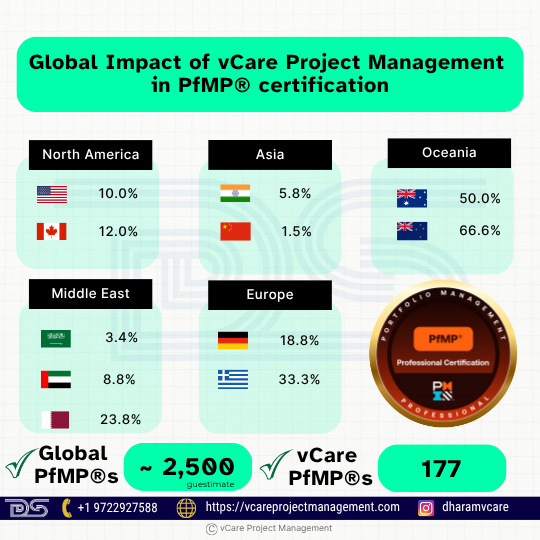
PfMP equips senior professionals to align portfolios with strategy and drive high-impact results—see how vCare supports global leaders in this mission.
These vCare contribution percentages clearly highlight the organization’s strong global presence and its impactful role in shaping certified leaders across continents.
According to the PMI Registry, the global certification landscape shows that China has approximately 2580+ PgMP’s and the United States has approximately 1500+ PgMP’s and these are the top two countries in the world for PgMP® certifications, reflecting their deep investment in advanced program management capabilities. When it comes to PfMP®, the The United States continues to lead globally with approximately 574+ PfMPs, while Saudi Arabia, now in second place with around 564+, is rapidly closing the gap in its push to become the global leader in strategic portfolio management.
Against this global backdrop, vCare’s consistent mentoring excellence continues to empower professionals to not only earn these elite credentials but to lead with clarity, confidence, and purpose.
The Certification Mindset: Forging Resilient, Strategic Leaders for a Complex World
PgMP® and PfMP® certificates can change the way professionals think, which helps them lead with foresight, deal with complexity, and make sure that projects are in line with the goals of the organisation. This way of thinking promotes learning for life, self-control, and being open to change. It also helps people become stronger, by teaching them how to deal with uncertainty, stay focused, and think critically. Certified leaders are renowned for their expertise and the way they use it in a world where things are always evolving, breakdown, and generating new concepts. You must think like this if you want to be a successful leader and remain relevant for a long time.
AI in Project Management: Disruptor, Enabler, or Strategic Partner?
AI is transforming the project management environment across various sectors, with experts unsure whether it is a strategic partner, enabler, or disruptor. However, when approached with knowledge and preparedness, AI becomes a strong facilitator, automating operations, boosting risk management, and streamlining resource planning. This allows project managers to focus on higher-value work, such as strategic decision-making, innovation, and stakeholder engagement.
AI makes consistent decision-making easier, implementation faster, and reduces complexity. Real-time data insights help teams work more efficiently and adapt quickly. Incorporating AI tools into daily project processes is essential for modern project ecosystems, reducing manual errors, improving accuracy, and ensuring on-time delivery.
AI can handle and analyze large amounts of data, but ethical supervision, context, and direction still rely on human leadership. Merging artificial intelligence with human insight leads to better outcomes, imagination, and strong project plans. Project managers must appreciate the possibilities of AI and use it appropriately, as those who see AI as an enabler of smarter, more agile project management rather than a threat will be ideally positioned to lead the next generation of high-performing, technology-driven projects.
Staying Human in the Age of AI: Essential Practices for Project Leaders
The role of a project leader, in my opinion, becomes even more human-centric as AI continues to change the field of project management. I adhere to the following crucial procedures and advise others who want to lead successfully in this AI-driven age:
1. Stress the importance of emotional intelligence and empathy – Make a human connection with your teammates. The emotional depth needed to inspire and establish trust cannot be replaced by technology.
2. Pay attention to stakeholder communication – Leaders need to manage relationships while AI handles data. Communication that is honest, transparent, and compassionate is still essential.
3. Combine judgement and data – Utilise AI-generated insights, but always use human judgement to understand long-term effects, context, and values.
4. Establish a culture of education – Teams should be encouraged to remain inquisitive and receptive to advancements in technology and people.
5. Encourage morality and diversity – Make sure AI-powered decisions are impartial, open, and consistent with moral principles.
6. Set a good example – Exhibit resilience, humility, and flexibility. More than any algorithm, these human qualities motivate teams.
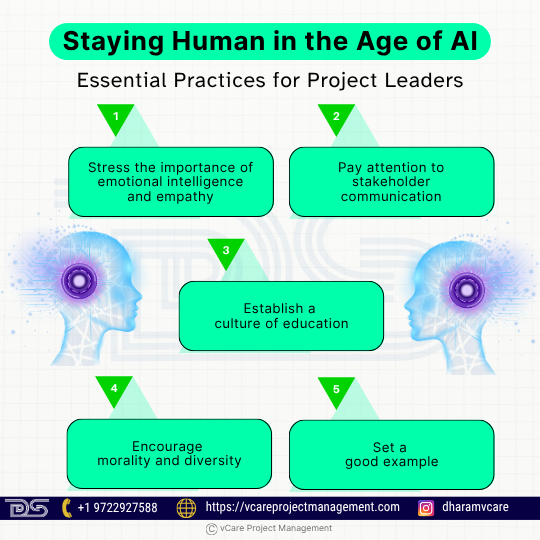
AI is reshaping project management, but empathy, ethics, and human judgement are what set great leaders apart.
The goal of remaining human is not to oppose AI. It involves balancing it with the enduring principles of leadership – vision, integrity, and compassion.
How PMI’s PMO Certification (PMOCP) Is Shaping the Future of Project Management Offices
I consider the PMI-PMOCP™ to be a strategic and timely development for PMO professionals. By coordinating project execution with overarching business objectives, the PMI PMOCP™ certification aims to identify and enable strategic PMO leadership. It emphasises practical, real-world skills like influence, agility, governance, and stakeholder engagement, all of which are critical in today’s changing environments.
By equipping professionals to lead significant organisational change rather than merely concentrating on status updates, it also fills important skill gaps in today’s PMOs. I gave a thorough rundown of the exam structure, application procedure, and efficient study methods in our most recent vCare webinar.
Having the PMOCP™ certification improves one’s reputation internationally and opens doors in various sectors and geographical areas. This certificate helps professionals land important roles and make strategic contributions to their organisations, whether they are creating a new PMO or expanding an existing one.
vCare Project Management is hosting a special webinar on the PMI-PMOCP™. The session features Kim Marcelliano, Senior Product Manager at PMI. She will share strategic insights on the credential’s relevance and target audience, while I will explain the exam structure, application process, and preparation tips. With their combined expertise, the webinar offers a clear path to PMO certification success. Ideal for PMO leaders and aspiring professionals, this session will provide valuable guidance to advance your career and strengthen your PMO’s strategic impact. So, don’t miss this opportunity, do check the webinar if you are interested.
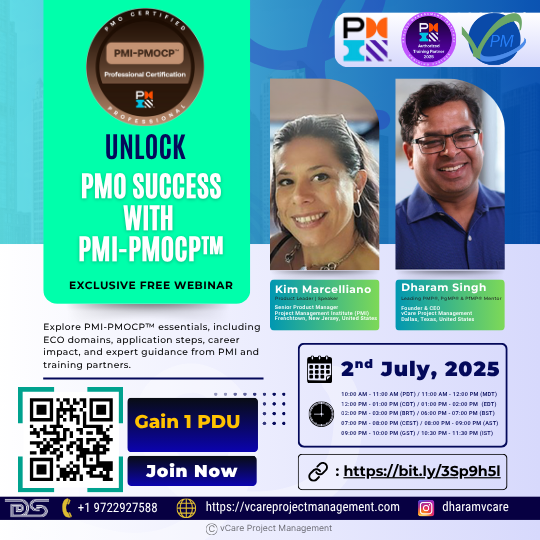
PMI-PMOCP is redefining PMO leadership. Learn how this new certification aligns strategy, agility, and impact.
Register Now: https://bit.ly/3Sp9h5l
Date: Wednesday, 02nd July 2025
Time: 10:00 AM – 11:00 AM (PDT) / 11:00 AM – 12:00 PM (MDT) / 12:00 PM – 01:00 PM (CDT) / 01:00 PM – 02:00 PM (EDT) / 02:00 PM – 03:00 PM (BRT) / 07:00 PM – 08:00 PM (CEST) / 08:00 PM – 09:00 PM (AST) / 09:00 PM – 10:00 PM (GST) / 10:30 PM – 11:30 PM (IST)
Guiding the Next Generation: My Approach to PgMP® and PfMP® Mentoring
Being a mentor is not just what I do, it’s what keeps me growing. Every interaction teaches me something new. While I have had the privilege of guiding over 570 PgMP®s and 177 PfMP®s worldwide, I consider myself a co-learner in this journey, growing alongside every professional I mentor.
PgMP® and PfMP® are more than just certifications. They stand for advanced governance skills, strategic thinking, and the capacity to match organizational objectives with program and portfolio objectives. The need for leaders with this degree of experience is growing as the project economy develops. These qualifications are increasingly crucial indicators of leadership prepared for the future.
Making this journey both meaningful and attainable is our mission at vCare Project Management. With tested mentoring models, organized preparation programs, and continuous support, we give candidates a clear path forward. Our goal is to help you pass, but we also want to help you become more confident and clear-headed in the process.
I provide advice to each person I mentor based on practical difficulties and knowledge gathered over many years of experience. There is no shortcut to success in PgMP® or PfMP®. It all comes down to comprehension, attitude, and steady support.
vCare Project Management can help you make the next big career move with purpose and precision.
The Road Ahead: Lifelong Learning and Collective Growth Beyond 55
As I turn 55, it feels perfectly timed that I have had the privilege of mentoring over 555+ aspirants, one for every year of my life and a few extra for good measure.
But a journey doesn’t end when you turn 55, but it marks the start of a new chapter based on in-depth education, significant mentoring, and a mutual dedication to the advancement of the field. There is a greater need than ever for strategic, forward-thinking leaders as the project landscape changes quickly and artificial intelligence changes how we lead and deliver.
There are still not many PgMP® and PfMP® certified professionals in the world, there are only 2500 PfMP®’s and 7900 PgMP®’s. Aspiring professionals have a significant opportunity here. These certifications represent more than just accomplishments. They serve as indicators of maturity, foresight, and the capacity to influence programs and portfolios.
“The function of leadership is to produce more leaders, not more followers.” – Ralph Nader
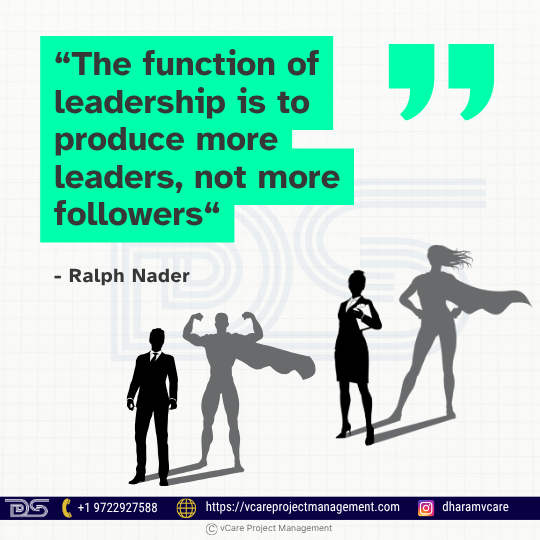
As Dharam Singh turns 55, he reflects on mentoring 555+ leaders and shaping the future of project and portfolio excellence.
Our goal at vCare Project Management is to enable people by providing them with organised mentoring, insightful guidance, and constant encouragement. We assist professionals in developing their leadership skills as well as their knowledge.
Now is a good time to think about your next project leadership move. The world needs competent, qualified individuals who are prepared to lead with clarity and purpose. At vCare, we are ready to provide you with forthright and specialist support during that journey.
Note: The figure of globally certified PgMPs & PfMPs is a guestimate based on available public sources and professional observations. Actual numbers may vary as PMI does not always publish real-time global certification data.
#DharamSingh #55YearsOfPurpose #PgMP #PfMP #PMOCP #ProjectLeadership #vCareProjectManagement #MentorshipMatters #StrategicPMO #AIandLeadership #PMICertification #FutureOfPMO #ProjectEconomy #PortfolioManagement #GlobalMentor #LeadershipReflection #LifelongLearning #EmotionalIntelligence #ProjectManagement
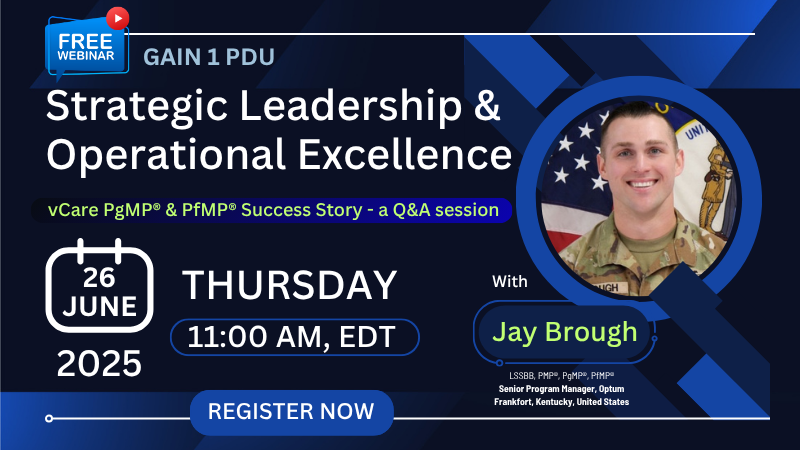
by DharamCW | Jun 15, 2025 | Project-Program-Portfolio Management Knowledge, Uncategorized
🎯 Upcoming Webinar – Strategic Leadership & Operational Excellence
I’m excited to invite you to a power-packed webinar hosted by vCare Project Management, featuring Jay Brough, PfPM, PgPM, PMP, LSSBB – a decorated U.S. Army veteran and program management leader from Frankfort, Kentucky, USA.
I’ll be hosting this exclusive session, where we dive into powerful leadership lessons and strategies that bridge military precision with corporate agility.
🔗 Reserve Your Spot Now: https://bit.ly/41sSraX
Date : Thursday, 26th June 2025
Time : 08:00 AM – 09:00 AM (PDT) / 09:00 AM – 10:00 AM (MDT)
10:00 AM – 11:00 AM (CDT) / 11:00 AM – 12:00 PM (EDT)
12:00 PM – 01:00 PM (BRT) / 04:00 PM – 05:00 PM (BST)
05:00 PM – 06:00 PM (CEST) / 06:00 PM – 07:00 PM (AST)
07:00 PM – 08:00 PM (GST) / 08:30 PM – 09:30 PM (IST)
🌟 Key Topics:
-> Bridging Military Leadership with Corporate Agility
-> Ensuring Operational Security & Compliance in a Cyber-Threat Landscape
-> The Role of AI in Strategic Decision-Making
-> Crisis Leadership: Lessons from the Military for Corporate Resilience
-> Universal Leadership Strategies Across Sectors
Upcoming Online Mentoring Programs:
PgMP: http://bit.ly/2oBKQXQ
PfMP: http://bit.ly/39jOZSf
🎁 Bonus Takeaways:
✔️ 1 PDU
✔️ Certification & Career Insights
✔️ Exclusive discounts on upcoming PMP, PgMP & PfMP programs
📞 Book a 15-minute call with me for career guidance: https://lnkd.in/gU79KD4K
🎧 Subscribe for Stories & Insights: https://bit.ly/2YF0wJl | https://bit.ly/2NDY8wd
#StrategicLeadership #OperationalExcellence #JayBrough #DharamSingh #vCareProjectManagement #PMIwebinar #PMICertifications #PgMP #PfMP #PMP #LeadershipWebinar #MilitaryToCorporate #AILeadership #CyberSecurity #PMO #CareerDevelopment #CrisisLeadership #StrategyExecution #PMI #Earn1PDU
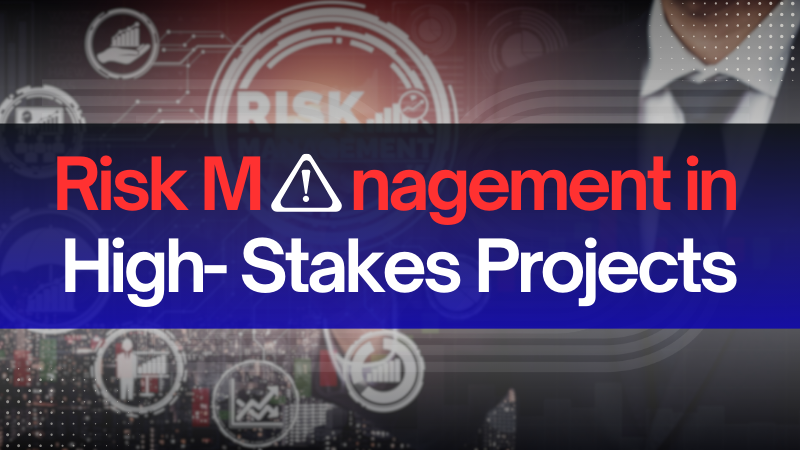
by DharamCW | Apr 25, 2025 | Project-Program-Portfolio Management Knowledge, Risk Management
In the current fast-paced corporate world, high-stakes projects create difficulties that can significantly affect an organization’s performance. The stakes frequently remain quite high, regardless of the endeavor – a multi-million-dollar software launch, a building project, or an event organizing campaign. Effective risk management becomes essential to recognize the potential risks and develop mitigation plans. This article explores risk management theory and presents practical solutions to ensure project success despite uncertainty.
The World Economic Forum’s 2024 Global Risks Report highlights the necessity for strong risk management frameworks in high-stakes projects and the growing complexity of global threats. Knowing how to manage risks entails more than simply avoiding problems; it also entails taking advantage of the possibilities that present themselves. Effective management enables teams to push limits and generate outstanding results while navigating through uncertainty. When the proper frameworks and methods are in place, high-stakes projects can achieve more success and innovation in addition to meeting their project goals.
Defining High-Stakes Projects
Project risk management refers to the systematic process that project managers use to detect, evaluate, and mitigate risks that might impede a project’s goals. By anticipating and mitigating these risks, project managers can prevent such setbacks from halting development. Project risk management helps teams to foresee possible problems and formulate tactical solutions that promote the project’s successful conclusion.
McKinsey’s analysis large-scale infrastructure projects and underscores the critical factors that categorize them as high-stakes, including significant capital investment and potential societal impact. Among the giants of the corporate world, big projects exhibit significant complexity and high risks.
Large-scale projects are fundamentally characterized by their complexity, magnitude, and the sometimes revolutionary change they bring about, in addition to their significant financial commitment and lengthy deadlines. These projects are distinguished by their scope and ambition, whether they include building a cross-country pipeline, implementing an across-the-nation IT system, or planning an international marketing campaign.
Why Risk Management is Essential in High-Stakes Projects
Deloitte’s Global Risk Management Survey indicates that 84% of organizations consider risk management is crucial for achieving strategic objectives in high-stakes environments. In order to foresee and control possible issues that can have a negative impact on project budgets, schedules, and results, project risk management is essential. Teams may identify project risks early and make sure they have backup plans in place by implementing a risk management approach. By being a project leader, keeping team members aware and ready for any risks, this not only protects project goals but also fosters teamwork.
Key reasons why risk management is critical in high-stakes projects:
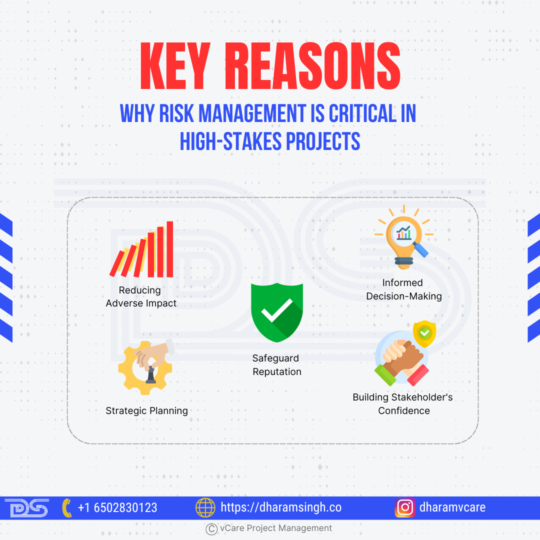
Proactive risk management ensures success in complex, high-value projects by preventing disruptions and improving decision-making.
Reducing adverse impact
Potential risks are detected early, which enables project teams to develop proactive measures to prevent or mitigate them, this method aids in avoiding major disruptions and costly delays.
Informed decision-making
Risk analysis provides a good insight into the potential implications of different scenarios, thus better decision-making is ensured throughout the project lifecycle.
Strategic planning
The clear understanding of risks helps in preparing contingency plans and allocating appropriate resources to take care of vital issues.
Building stakeholder’s confidence
Developing a comprehensive risk management process provides stakeholders with confidence that a project is properly equipped to take on the adversities.
Safeguard reputation
Organizations can protect their reputations from drastic damage due to unanticipated incidents when they can manage risks actively.
Types of Risks in High-Stakes Projects
In order to prevent or reduce loss or company failure, a project risk analysis tracks a project’s performance from inception to conclusion. Depending on the project’s nature, level of complexity, and length, different risks have different origins. Understanding the typical project management risk types may aid in spotting potential risks, assessing their effects, and organizing the countermeasures.
Why is project risk analysis important?
Because it assists project managers in determining a project’s strengths, weaknesses, and potential opportunities during or after completion, so project risk analysis is crucial. It might be crucial to get knowledgeable about the possible issues or “high-risk” dangers that could jeopardize the successful completion of a planned project in order to conduct an effective risk analysis.
To prevent or reduce losses in an ongoing project, it is crucial to make a list of all the unforeseen circumstances that might interfere with the technology, resources, and procedures. A complete mitigation strategy requires a detailed readiness plan in order to handle losses efficiently.
Reducing the size of both internal and external risks is the goal of project risk analysis. The goal is to use a proactive approach to project management instead of a reactive one. It seeks to reassure the stakeholders that, in spite of the difficulties, the project’s goals will be achieved. Through risk analysis, a competent project manager and knowledgeable technical staff form a powerful team that management leads to close gaps and take advantage of opportunities within their respective areas of competence.
Common types of project risks
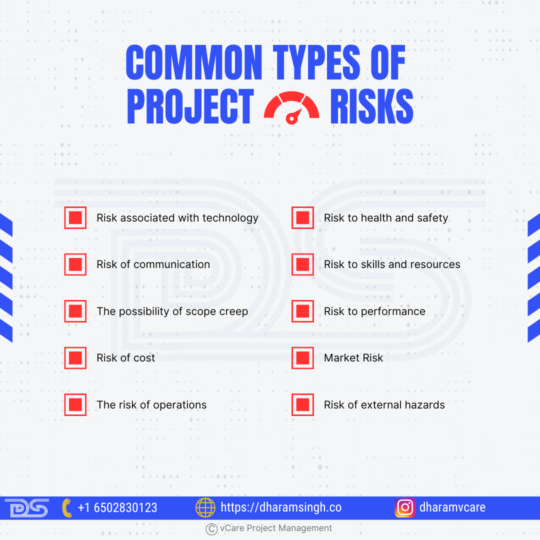
Understanding the types of project risks helps leaders build targeted mitigation strategies to improve project outcomes.
1. Risk associated with technology
The frequent turnover of new and sophisticated technologies makes project managers find the technology side of project management a challenging deliverable. A project’s technological component puts data security, organization services, compliance, and information security at risk. Managers find technology-related risks more difficult to manage since they often need to hire new staff and purchase software when introducing new IT systems. Other risks associated with technology include service outages, which might cause delays and project failure.
2. Risk of communication
When you control a project, closely adhering to the important work ethic of effective and timely communication might be helpful. You can monitor any changes, distribute work, and promote a cohesive team atmosphere by scheduling meetings with stakeholders, including project sponsors. With so many devices and communication channels at our disposal, team members occasionally overlook the essential elements of good communication, which can lead to data loss or disinformation and ultimately disrupt the project.
3. The possibility of scope creep
Unauthorized and uncontrolled changes to the project’s original scope might lead to additional expenses for features, goods, or services. Almost all projects face this risk, and while some stakeholders find the additional features important for the project’s success, that can occasionally create a permanent challenge.
4. Risk of cost
The project’s completion might be threatened by a lack of cash or poor financial management brought on by an overly ambitious budget or other limitations. The risk may move to other operations and labor segments if the project cost exceeds the allocated budget. A scope risk might also arise as a result of the funds being reduced.
5. The risk of operations
Inadequate execution of critical operations and fundamental processes, including manufacturing or procurement, can stagnate or end a project. Inadequate or unsuccessful qualitative and quantitative techniques might lead to a loss, either direct or indirect, due to these risks.
6. Risk to health and safety
One kind of risk that may undermine a business’s compliance policies is health and safety. Organizations must routinely review and monitor their health and safety policies to spot the risks that can cause losses or penalties. Management is responsible for establishing ongoing health and safety risk monitoring for the company’s facilities, goods, and services.
7. Risk to skills and resources
Because project operations might occasionally stagger in distinct waves at multiple sites, requiring in-house personnel attendance, using internal workers carries a potentially significant project risk. The overlap of the waves creates a possible cause of discomfort. Another risk that might increase the costs of staff transfers or retraining is staff ineptitude across different project divisions.
8. Risk to performance
There is a perceived performance risk when a project is unlikely to produce the desired outcomes. The risk inevitably affects the business’s overall performance. The performance of the competitors may be impacted, more funding may be needed, and nonperformance may result in a penalty.
9. Market Risk
Market risk is likely to arise when a project does not achieve the desired outcomes. The advantage might be used by rivals to hinder the company and drive it off the market. Commodity and international market patterns pose an additional market risk that might undermine the project’s early projections. Another possible market distraction to the project’s product sales is liquidity, credit, and interest rate fluctuations.
10. Risk of external hazards
A possible risk is a likely unfavorable event that is out of the project manager’s control. These risks can take many different forms, such as civil unrest, earthquakes, floods, vandalism, terrorism, and storms. In such cases, a project may stagnate or end. Organizations can avoid significant losses or damage brought on by unanticipated external hazards by using the proper monitoring plans.
Understanding Risk Management Framework (RMF)
Effective risk management is essential to any well-managed business’s drive for stability and expansion. Incorporating best practices into the company’s risk culture through the implementation of a risk management framework helps guarantee that it can endure future threats that are both predicted and unanticipated.
For instance, risk management is a key component of investment industry businesses, which enables them to weather significant market downturns.
Is Risk Mitigation is important in project management?
The process of reducing, managing, or eliminating risks or threats to a project’s goals is known as risk mitigation, and it is a crucial part of project planning. Risks that a project may encounter include scope creep, missing deadlines, higher than expected expenses, and project team turnover.
The project team evaluates the possible risks’ relevance by conducting a risk assessment after they have been discovered. The sorts of risks, their possible effects on the project, and their likelihood of occurring are all made clear by this evaluation. The choice of suitable risk reduction techniques is influenced by these elements as well as the cost of mitigation.
According to McKinsey’s research, companies with proactive risk mitigation strategies are 43% more likely to achieve project success in volatile markets.
Risk mitigation strategies
Project teams might pick from a variety of risk reduction techniques. Five of the most popular risk mitigation techniques that may be applied to address, control, or eradicate hazards are as follows:
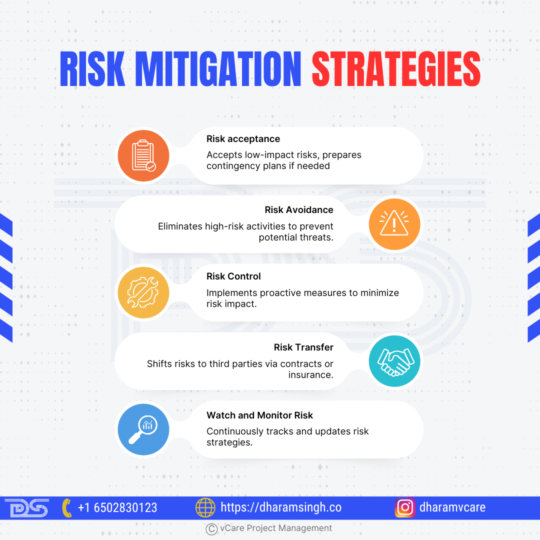
Discover the five most effective risk mitigation strategies to address and manage project uncertainties for enhanced success and stability across all phases.
1. Risk acceptance
Determining if a project’s risks are acceptable is part of the acceptance risk mitigation method. This usually happens in situations where the risk’s effect or likelihood of happening are deemed minimal. When the cost of risk mitigation exceeds the cost of the risk happening, risk acceptance can also be put into practice.
When a risk is considered acceptable, no steps are made to reduce it, however there could be a strategy in place to deal with it should it materialize. This strategy entails accepting the risk’s potentiality and becoming ready to handle it if needed.
2. Risk avoidance
Any action will typically be performed to prevent a danger from happening when employing the risk avoidance technique. Since these steps can occasionally be expensive, this risk mitigation technique is frequently selected when a danger is thought to constitute a significant risk.
3. Risk control
A control plan can also be used by team members to reduce project risks. By addressing the risk through actions or regulations, this risk reduction technique works.
4. Risk transfer
Another effective risk reduction tactic is to shift the recognized risks to another party in order to lessen their effects. This tactic should be applied in a manner that all parties can agree with, however it may have disadvantages and extra expenses.
5. Watch and monitor risk
Employing this risk mitigation technique entails keeping an eye out for and recognizing any changes that could have an influence on a risk’s impact. Production teams may incorporate this tactic into their plan for project reviews. A project’s budget, timeline, and performance may all be tracked for emerging or shifting risks.
How do you pick the best mitigation plan?
Knowing which risks are most important to the company will help you select the best mitigation plan because different risk categories require different approaches. In order to guarantee the effective execution of a risk mitigation plan, you may also take into account the organization’s current resources. Additionally, you might examine past tactics employed by the business or its rivals in order to duplicate effective methods.
The Importance of Managing and Controlling Risks
Risk management is a crucial activity because it equips a company with the resources it needs to recognize and address any threats. Risk mitigation is simple once it has been identified. Furthermore, a firm may make wise decisions by using the foundation that risk management offers.
Assessing and managing risks is the greatest approach for a firm to be ready for any scenario that might impede its development and expansion. Businesses have a better chance of succeeding when they assess how they intend to handle possible challenges and then create mechanisms to deal with them.
Furthermore, progressive risk management guarantees that high-priority risks are addressed as forcefully as feasible. Additionally, the management will have access to the data they need to make wise choices and maintain the company’s profitability.
Risk Analysis Process
Risk analysis is a qualitative method to problem-solving that analyzes and determines risks in order to evaluate and address them using a variety of evaluation techniques. The risk analysis procedure is as follows:
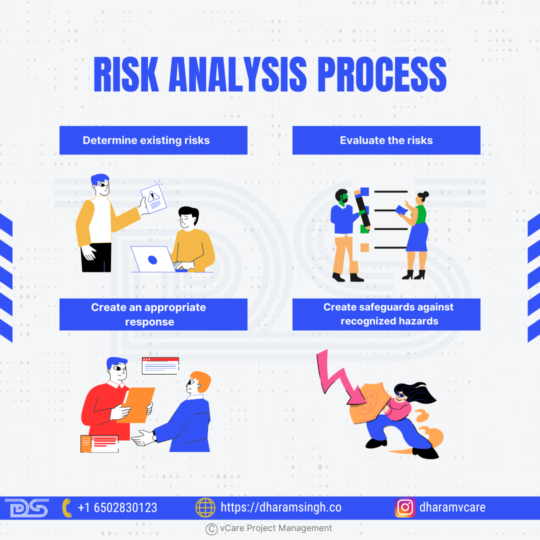
A well-structured risk analysis process empowers teams to detect, evaluate, and respond to risks with precision and foresight.
1. Determine existing risks
The primary method for identifying risks is brainstorming. To assess all the many sources of risk, a company brings its employees together. Sorting all of the risks that have been discovered according to priority is the next stage. Prioritization makes ensuring that risks that have the potential to have a major impact on an organization are addressed more quickly since it is impossible to minimize every risk that currently exists.
2. Evaluate the risks
Problem solving frequently entails first recognizing the issue and then coming up with a suitable fix. However, a company should identify the source of the risks by asking, “What caused such a risk and how could it influence the business?” before determining how to manage them.
3. Create an appropriate response
The following questions must be asked by a corporate entity after it has decided to evaluate potential solutions to reduce recognized risks and stop them from happening again:
· What steps can be made to stop the danger from happening again?
· What should be done in the event that it recurs?
4. Create safeguards against recognized hazards
In this case, the concepts that were determined to be helpful in risk mitigation are expanded into a variety of activities and subsequently into future-deployable strategies. Plans can be implemented in the event that risks materialize.
Risk Management Tools and Techniques
Tools for risk management are procedures, software programs, and methods created to recognize, assess, and rank risks. In order to reduce the potential consequences of any risk, they are executed through resource coordination. These risk management tools cover a range of features that assist firms in anticipating potential risks and putting effective mitigation plans into place, from risk assessment frameworks to financial and analytical tools. Maintaining the general health of the company, securing the organization’s assets, and guaranteeing project success are the ultimate objectives.
The Value of Risk Management Tools and Techniques in Risk Mitigation
It is necessary to discuss the importance of techniques for risk management and tools. Effective risk management has become crucial as a result of the world’s uncertainties and the speed at which technology is developing. These tools offer a number of significant advantages:
· Proactive Risk Identification: Rather than focusing on reactive solutions, risk management technologies assist firms in identifying potential risks and developing proactive solutions.
· Making Informed Decisions: By evaluating possible effects and weighing risks against benefits, risk management tools assist in making well-informed decisions.
· Resource Optimization: By giving priority to risks that pose a greater danger, risk management solutions help allocate resources more efficiently.
· Governance and Compliance: By ensuring that firms adhere to governance norms and legal laws, many risk management techniques help to lower legal liability.
· Improved Communication: By providing a consistent framework for talking about risks, risk management technologies help teams and stakeholders communicate more effectively.
Tools and Techniques
Here is an overview of the best risk management tools and techniques:
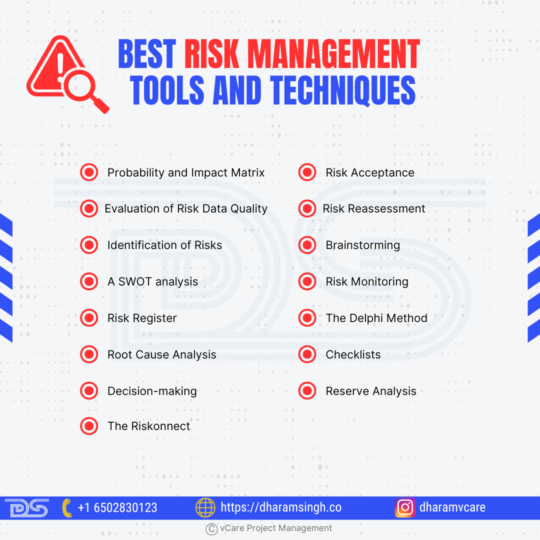
From qualitative tools like SWOT to advanced platforms like Riskonnect, the right mix of techniques strengthens your risk management strategy.
1. Probability and Impact Matrix
One essential tool for risk management is the Probability and Impact Matrix. It assesses and ranks risks according to their probability of happening and possible influence on project goals.
2. Evaluation of Risk Data Quality
In order to guarantee that risk management choices are founded on correct and superior information, risk data quality evaluation assesses the dependability and credibility of risk data.
3. Identification of Risks
An essential first step in the risk management process is risk identification. It accurately recognizes and records any risks to a project or company. To find possible risks and hazards, the business takes into account both internal and external elements. This makes it possible for enterprises to manage difficulties more effectively and lessen their effects.
4. A SWOT analysis
When it comes to project planning or company competitiveness, SWOT analysis is a strategic planning technique that helps identify strengths, weaknesses, opportunities, and threats.
5. Risk Register
Typically, a risk register is a document that includes all of the details concerning hazards that have been discovered, such as their status and strategies for mitigation.
6. Root Cause Analysis
A problem-solving technique called “root cause analysis” seeks to determine the primary source of danger or problems rather than just treating their symptoms.
7.Decision-making
Making decisions entails assessing possible risks and selecting the course of action that will have the least negative impact. Organizations may successfully reduce risks and handle uncertainties by including decision-making into risk management.
8. Risk Acceptance
A risk management technique known as “risk acceptance” involves choosing to accept the consequences of a risk without actively working to reduce it.
9. Risk Reassessment
By regularly reviewing the risk environment to find new risks and reassess old ones, risk reassessment makes ensuring that risk management plans are applicable and realistic.
10. Brainstorming
The innovative group problem-solving method known as brainstorming produces a large number of concepts for risk detection and mitigation plans.
11. Risk Monitoring
In order to identify risks, track lingering threats, and spot new ones, risk monitoring is a crucial step in risk management.
12. The Delphi Method
Developed as an interactive, methodical forecasting process with a panel of experts, the Delphi Technique is a structured communication strategy.
13. Checklists
To make sure the company takes into account all possible project risks and the required risk management procedures, checklists are straightforward yet powerful tools.
14. Reserve Analysis
Reserve analysis is the process of allocating contingency reserves (money, time, or resources) to deal with risks that could be more likely to materialize and have a greater impact.
15. The Riskonnect
Leading integrated risk management software provider Riskonnect provides a full range of tools to assist businesses in recognizing, controlling, and reducing risks throughout their operations.
Are Future Risks Predictable by Risk Management Tools?
Tools for risk management assist businesses in recognizing, evaluating, and reducing risks. Although they are essential for identifying possible risks based on data that is now available and past patterns, it is vital to understand their potential for risk prediction in the future.
Some of the Capabilities involved are:
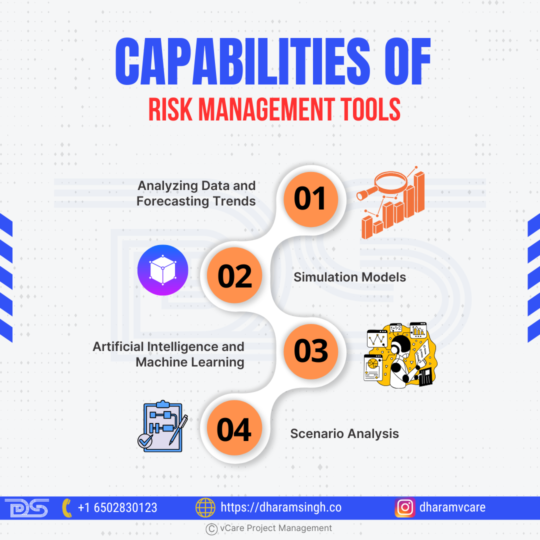
Risk management tools can’t predict the future perfectly—but with AI, simulations, and predictive models, they help teams prepare for what might come.
1. Analyzing Data and Forecasting Trends
Data analytics is used by many risk management technologies to find trends and patterns in historical data. This might include external market dynamics, operational mishaps, and financial performance. The technologies can predict possible future threats by examining these tendencies. For this, predictive analysis may be useful.
2. Simulation Models
Numerous possibilities based on various assumptions and inputs may be explored with the use of tools such as Monte Carlo simulations. By offering a variety of possibilities together with probabilities, these simulations can assist firms in comprehending possible future risks under various circumstances.
3. Artificial Intelligence and Machine Learning
By examining enormous volumes of data, including unstructured data from news stories, social media, and other digital platforms, artificial intelligence (AI) and machine learning algorithms are able to forecast possible future risks. These tools are able to identify new patterns and possible danger signs that conventional research can miss.
4. Scenario Analysis
Scenario analysis-facilitating risk management tools allow firms to investigate the effects of different fictitious future scenarios. Even if it is impossible to forecast the precise kind or timing of a risk, this can assist prepare for potential outcomes.
Some of the Restrictions involved are:
1. Reliance on Past Information
Assuming that future occurrences would follow similar patterns, predictions are frequently based on previous data. This method might not be able to anticipate black swan occurrences or unusual risks with enough accuracy.
2. Changing Variables
Rapid changes in factors, such as advancements in technology, changes in geopolitics, and unforeseen worldwide occurrences like pandemics, can make prediction models less accurate.
3. Risks’ Complexity and Interconnectedness
Risks in the modern world are becoming more intricate and linked. The cascading impacts of a single risk on other facets of a company or the global economy may not be fully captured by traditional techniques.
4. Subjectivity and Prejudice
The results of risk assessments may be skewed by subjectivity and bias introduced by the input parameters and underlying assumptions of risk projections.
What Impacts Do Regulatory Changes Have on Risk Management Strategies?
Regulatory changes have a significant impact on risk management methods because they may provide new compliance requirements that firms must meet within tight deadlines. The operations, financial reports, and data management of a business may be impacted by such changes. In order to remain compliant, businesses must monitor and adapt their risk mitigation strategies. This lowers the risks associated with non-compliance, such as legal fines, monetary losses, or harm to the company’s reputation. Effective risk management in this context means discussing new laws and regulations, assessing their potential implications, and making the required adjustments to maintain the firm’s risk portfolio consistent with the current regulatory environment.
Direct Effects on Strategies for Risk Management
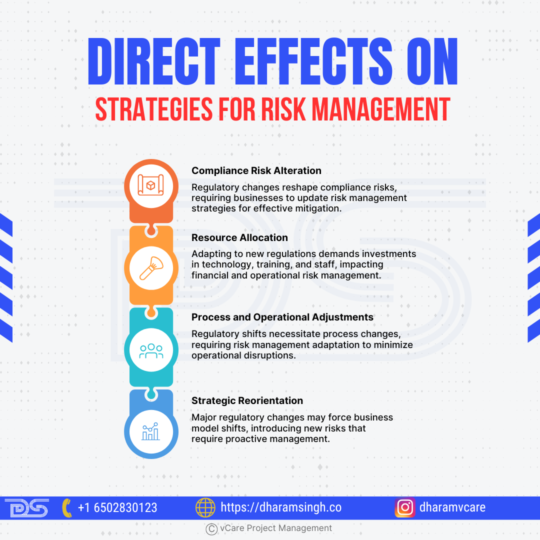
Understand how regulatory shifts impact risk management strategies directly through compliance and operations, and indirectly through technology, market dynamics, and stakeholder trust.
1. Compliance Risk Alteration: An organization’s compliance risk profile is directly impacted by new legislation or changes to current ones. To handle these developments, organizations must modify their risk management plans, making sure that any new compliance risks are recognized, evaluated, and successfully reduced.
2. Resource Allocation: Reallocating resources is frequently necessary when implementing modifications to comply with new laws. To handle compliance, this may entail making investments in new technology, educating employees, or recruiting more staff. The organization’s operational and financial risk management plans may be impacted by such modifications.
3. Process and Operational Adjustments: Organizational structures, operational procedures, and business processes may need to be altered in response to regulatory changes. In order to detect new risks brought about by these changes and minimize any possible effects on the organization’s goals, risk management systems must adjust to these operational alterations.
4. Strategic Reorientation: Regulatory changes may occasionally be so radical that a reassessment of the company’s business plan is necessary. This might entail expanding into new markets, phasing out particular products, or altering the company plan, all of which contain risks that need to be control.
Effects of Indirect Risk Management Strategies
1. The dynamics of the market: The competitive landscape can be changed by regulatory changes, which can impact market dynamics and, in turn, the market risk of a business.
2. Technological Innovation: In order to comply with new rules, organizations may need to embrace new technology more quickly than they had previously thought. As the company works to adopt and integrate new technologies, this creates technical risks including cybersecurity threats and strategic hazards. It could be useful to keep an eye on technical developments.
3. Reputation and Stakeholder Relations: An organization’s reputation and relationships with stakeholders, such as investors, consumers, and regulatory agencies, can be impacted by how it handles regulatory changes. Managing these connections and perceptions must be a part of any effective risk management strategy.
The Best Methods for Handling the Risks of Regulatory Change
1. Proactive Analysis and Monitoring: Organizations may anticipate changes and modify their risk management plans appropriately by conducting proactive analysis of potential effects and ongoing monitoring of the regulatory environment.
2. Frameworks for Adaptive and Flexible Risk Management: Organizations can react quickly and efficiently by creating adaptable risk management frameworks that can quickly adjust to changes in the regulatory environment.
3. Stakeholder Engagement: Talking with industry associations, regulators, and other stakeholders can help you understand possible changes to the law and provide you ways to influence its creation.
4. Integrated Compliance and Risk Management: A comprehensive strategy for handling the effects of regulatory changes is ensured by combining compliance management with more general risk management procedures.
Conclusion
Inherently, high-stakes projects include significant financial outlays, complex stakeholder relationships, and significant strategic implications. These programs cover critical industries including technology, healthcare, infrastructure, and aircraft; failures might lead to serious financial losses, harm to one’s reputation, and even fatalities. Because of these risks, the firm needs to create a strong and thorough risk management system to ensure success.
Stakeholders must recognize, evaluate, and mitigate the vast range of risks connected to high-stakes projects using a systematic approach to risk management. Some of these risks include regulatory non-compliance, technical disruptions, financial instability, operational inefficiencies, and geopolitical uncertainty. When a proactive risk management plan is not in place, teams face a far greater likelihood of project failure, which can have detrimental ripple effects both inside and beyond the company.
To minimize any interruptions and guarantee that projects stay on course, organizations must implement effective risk mitigation techniques. These initiatives include dynamic stakeholder interaction, well-defined contingency planning, comprehensive risk assessment procedures, and flexible project management approaches. By skillfully combining these components, organizations can strengthen their resilience and preserve operational integrity in unstable times.
Continuously monitoring and mitigating risks throughout the course of a project is equally important. To anticipate unanticipated difficulties, teams must implement strict risk monitoring, real-time reaction systems, and iterative modifications. Cutting-edge technology solutions, such as scenario-based modeling, real-time data monitoring, and AI-driven predictive analytics, enhance an organization’s capacity to successfully manage and reduce risks.
Airbus’s creation of the A380 is a noteworthy example of a risk management strategy that works well. After initially encountering significant technical difficulties, supply chain interruptions, and cost increases, Airbus used an integrated risk management approach. The company reorganized stakeholder alignment, developed strong cross-functional cooperation, and used advanced simulation models. These actions not only made it easier to finish the project, but they also demonstrated how crucial proactive risk reduction is in high-stakes project settings.
Looking ahead, risk management in high-stakes projects will gain greater importance from digital transformation, predictive analytics, and data-centric decision-making. If businesses adopt agile risk management frameworks and leverage emerging technology, they will be in a better position to manage uncertainty, allocate resources optimally, and achieve long-term, sustainable success. By fostering a culture of proactive risk management, businesses may improve project resilience, seize opportunities, and maintain a competitive advantage in a constantly changing global environment.
#RiskManagement #ProjectLeadership #HighStakesProjects #StrategicPlanning #ProjectSuccess #DeloitteInsights #McKinseyAnalysis #GlobalRisks2025 #ProjectManagement #RiskMitigation #CorporateStrategy #InfrastructureProjects #WEF2025 #ProjectDelivery #InnovationInProjects #ComplexProjects #RiskFrameworks #PMOLeadership #MitigationPlanning #vCareProjectManagement
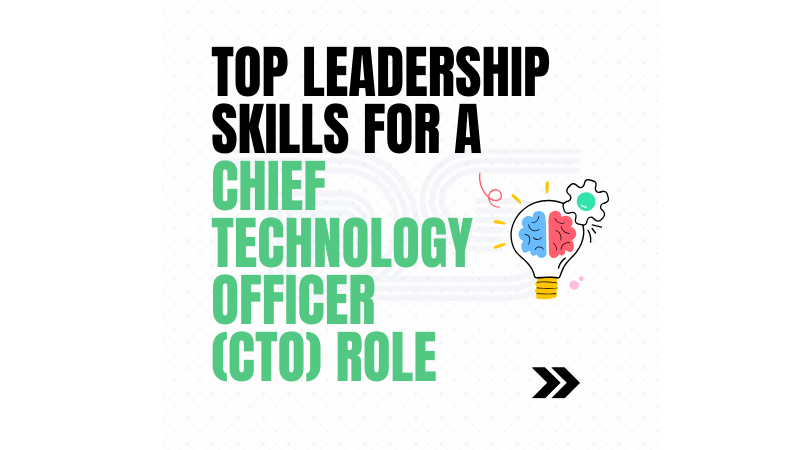
by DharamCW | Apr 24, 2025 | General, Project Management, Project-Program-Portfolio Management Knowledge
🔍 Top Leadership Skills for a Chief Technology Officer (CTO) Role
The role of a CTO goes far beyond just overseeing technology.
✅ Driving innovation
✅ Aligning tech with business goals
✅ Leading technical teams with expertise and vision
Here are 4 key leadership skills every aspiring or current CTO must master:
1️⃣ Mastering Strategic Thinking
Anticipate trends, align technology with business goals, and drive growth through informed decisions.
2️⃣ Excelling in Communication and Collaboration
Align stakeholders, inspire teams, and simplify technical concepts into actionable insights.
3️⃣ Staying Ahead with Technical Expertise
Balance leadership with up-to-date knowledge to drive innovation and maintain a competitive edge.
4️⃣ Leading and Developing High-Performing Teams
Empower employees, foster growth, and build a positive, performance-driven culture.
💬 Which of these skills do you believe is most critical for a CTO today?
Comment below and let’s spark a conversation.
🔁 Don’t forget to Like, Share, and Save this post if you found it insightful.
🔗 Want to explore more?
View our upcoming PgMP Programs
Online Training → http://bit.ly/2oBKQXQ
Direct Training → http://bit.ly/2oCfpg0
Explore Our PfMP Programs:
Online Training → http://bit.ly/39jOZSf
Direct Training → http://bit.ly/38er2M3
📞 For queries: +1 650-283-0123
🎥 Free Consultation with Me: https://lnkd.in/gwD-52JH
#CTO #LeadershipSkills #StrategicThinking #TechLeadership #Innovation #HighPerformingTeams #vCareProjectManagement #DharamSingh #TechnologyLeadership #BusinessStrategy #DigitalTransformation #ExecutiveLeadership #TeamDevelopment #CLevelSkills #CTORole #TechVision #InspireTeams #TechManagement #FutureLeadership #CTOSuccess
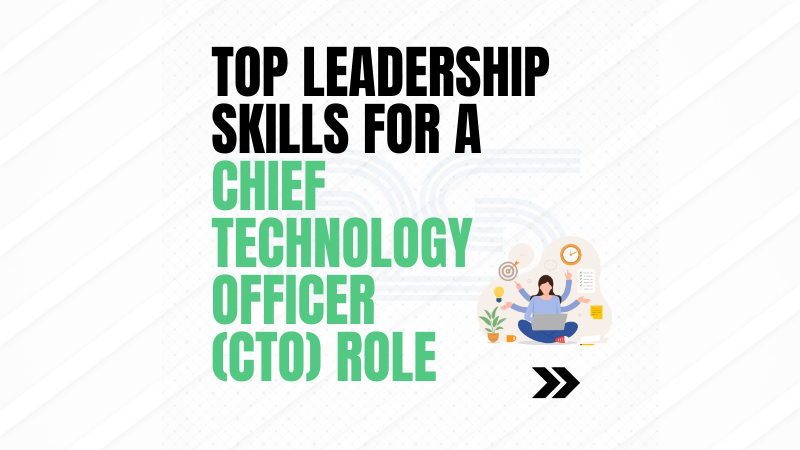
by DharamCW | Apr 16, 2025 | Industry Trends and Insights, Leadership in Project Management, Project-Program-Portfolio Management Knowledge
🔍 Top Leadership Skills for a Chief Technology Officer (CTO) Role
The role of a CTO goes far beyond just overseeing technology.
✅ Driving innovation
✅ Aligning tech with business goals
✅ Leading technical teams with expertise and vision
Here are 4 key leadership skills every aspiring or current CTO must master:
1️⃣ Mastering Strategic Thinking
Anticipate trends, align technology with business goals, and drive growth through informed decisions.
2️⃣ Excelling in Communication and Collaboration
Align stakeholders, inspire teams, and simplify technical concepts into actionable insights.
3️⃣ Staying Ahead with Technical Expertise
Balance leadership with up-to-date knowledge to drive innovation and maintain a competitive edge.
4️⃣ Leading and Developing High-Performing Teams
Empower employees, foster growth, and build a positive, performance-driven culture.
💬 Which of these skills do you believe is most critical for a CTO today?
Comment below and let’s spark a conversation.
🔁 Don’t forget to Like, Share, and Save this post if you found it insightful.
🔗 Want to explore more?
View our upcoming PgMP Programs
Online Training → http://bit.ly/2oBKQXQ
Direct Training → http://bit.ly/2oCfpg0
Explore Our PfMP Programs:
Online Training → http://bit.ly/39jOZSf
Direct Training → http://bit.ly/38er2M3
📞 For queries: +1 650-283-0123
🎥 Free Consultation with Me: https://lnkd.in/gwD-52JH
#CTO #LeadershipSkills #StrategicThinking #TechLeadership #Innovation #HighPerformingTeams #vCareProjectManagement #DharamSingh #PgMP #PfMP #TechnologyLeadership #BusinessStrategy #TechVision
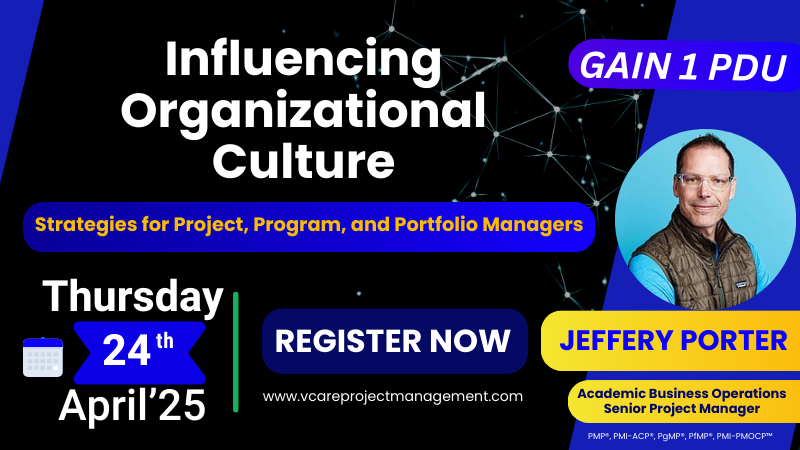
by DharamCW | Apr 12, 2025 | Professional Development Webinars, Project-Program-Portfolio Management Knowledge
🚀 Discover Actionable Strategies to Influence Organizational Culture!
Join us for an insightful session with Jeffery Porter, a respected authority in Project, Program, and Portfolio Management from Beatrice, Nebraska, USA.
With over 15+ years of experience managing multi-million-dollar portfolios and leading cultural transformations, Jeffery has helped organizations bridge the gap between strategy and culture—delivering consistent and impactful results.
🔗 Reserve your spot now: https://bit.ly/4ifsEsy
🧭 What You’ll Learn
✔ Understanding and Assessing Organizational Culture
✔ Aligning Cultural Initiatives with Strategic Goals
✔ The Role of Managers in Shaping Culture
✔ Case Study: Driving Positive Cultural Change
✔ Measuring the Impact of Culture-Driven Initiatives
✔ Thriving in Challenging Organizational Cultures
🎯 Don’t miss this opportunity to earn 1 PDU, gain valuable career and certification insights, and unlock exclusive offers on PMP, PgMP, and PfMP programs from vCare Project Management.
📅 Session Date: Thursday, 24th April 2025
🕒 Session Time:
11:00 AM – 12:00 PM (PDT) / 12:00 PM – 01:00 PM (MDT) / 01:00 PM – 02:00 PM (CDT) / 02:00 PM – 03:00 PM (EDT) / 03:00 PM – 04:00 PM (BRT) / 07:00 PM – 08:00 PM (BST)
08:00 PM – 09:00 PM (CEST) / 09:00 PM – 10:00 PM (AST) / 10:00 PM – 11:00 PM (GST)
View our upcoming PgMP® Programs
Online → http://bit.ly/2oBKQXQ
Direct → http://bit.ly/2oCfpg0
View our upcoming PfMP® Programs:
Online → http://bit.ly/39jOZSf
Direct → http://bit.ly/38er2M3
🎙️ Got questions about your Project Management career or PMI certifications?
Book your FREE 15-min session with me at 👉 www.talktodharam.com
📞 Contact Us
📱 Call: +1 650-283-0123 (U.S.)
📧 Email: info@vcareprojectmanagement.com
🎧 Subscribe & Stay Ahead
Success Stories: https://bit.ly/2YF0wJl
Podcasts & Interviews: https://bit.ly/2NDY8wd
#ProjectManagement #PgMP #PfMP #PMP #PMICertifications #Leadership #vCareProjectManagement #OrganizationalExcellence #DharamSinghPfMP #DharamSinghPgMP #PgMPTraining #JefferyPorter
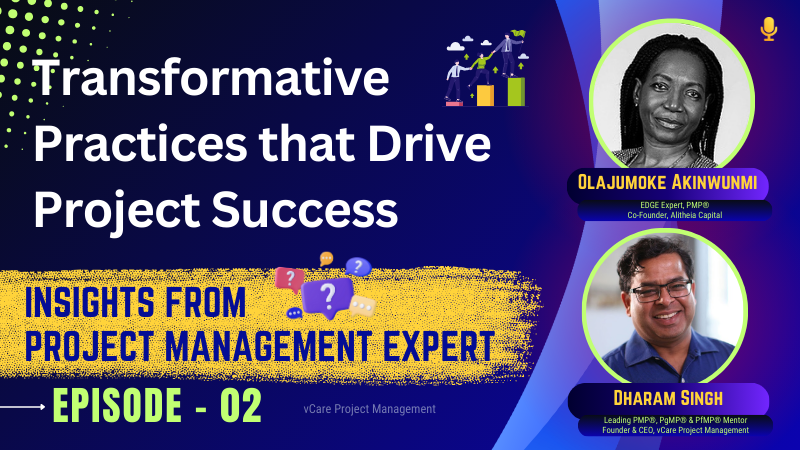
by DharamCW | Apr 3, 2025 | Professional Development Webinars, Project-Program-Portfolio Management Knowledge
🎯 Project success doesn’t come from flashy tools—it comes from purpose, clarity, and people.
In Episode 2 of the Innovative Project Management Practices series, I had the privilege of speaking with Olajumoke Akinwunmi, EDGE Expert & PMP®, about the real strategies that drive project excellence.
💬 We explored what truly transforms project delivery—not just emerging tech or trends, but:
🔹 Early stakeholder engagement
🔹 Clear communication and agile-inspired transparency
🔹 Meaningful team morale boosters
🔹 Smart but thoughtful tech adoption (yes, drones included!)
🔹 Negotiation strategies that build trust, not walls
This episode is a masterclass in grounded leadership, and Olajumoke’s insights are a must-listen for anyone managing complex projects or diverse teams.
📢 Listen Now & Share Your Thoughts:
🎧 Episode 1: Why PMP After 30 Years? 🔗 https://youtu.be/EIoOTElDZGU
🎧 Episode 2: Transformative Practices That Drive Project Success 🔗 https://youtu.be/3rzulUioix4
– Book an obligation-free consultation session on Project management Career, training, and certifications: http://talktodharam.com
– Discover training offers and certification discounts: https://bit.ly/3jWVepD
– Stay updated with our Q&A series and certification success stories by subscribing to the vCare Project Management YouTube channel at https://bit.ly/2YF0wJl
– Follow my podcasts and interviews with Project Management Experts on YouTube at https://bit.ly/2NDY8wd
Let me know your favorite takeaway in the comments!👇
#ProjectManagement #Leadership #StakeholderEngagement #TeamSuccess #AgileLeadership #TechnologyInProjects #PMP #DharamSingh #VCareSuccess #ProjectDelivery #WomenInLeadership #OlajumokeAkinwunmi
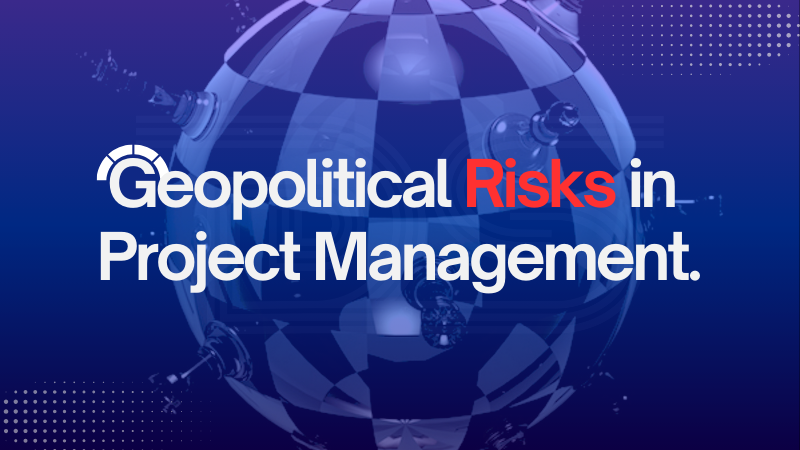
by DharamCW | Mar 28, 2025 | Industry Trends and Insights, Leadership in Project Management, Project-Program-Portfolio Management Knowledge
In today’s incorporated global economy, top-level project managers must navigate a more complex environment shaped by geopolitical risks. Economic instability, supply chain interruptions, unpredictable politics, and regulatory changes no longer represent small problems; rather, they create significant roadblocks that can make or break businesses. As businesses expand globally, they find that strategic risk management becomes more crucial.
In project management, uncertainties like international conflicts, diplomatic tensions, political choices, and economic policies are referred as geopolitical risks. In a recent Project Management Institute (PMI) survey, more than 60% of international project managers cited geopolitical instability as an imminent threat to project performance. Furthermore, McKinsey’s 2023 Global Risk Report emphasized how challenges associated with compliance and regulations compel companies to re-evaluate their plans.
This article will examine how businesses effectively address geopolitical risks by utilizing case studies from sectors including technology, infrastructure, and energy. In addition, during geopolitical risks, leadership insights and best practices will provide practical methods for reducing risks and ensuring project continuity.
Geopolitical Risks in Project Management
Project managers in today’s rapidly changing world must navigate geopolitics, budgets, and schedules, as well as potential risks like policy changes and economic downturns. Early identification of these risks and getting prepared for the solution are crucial for project success by ensuring a smooth execution of plans.
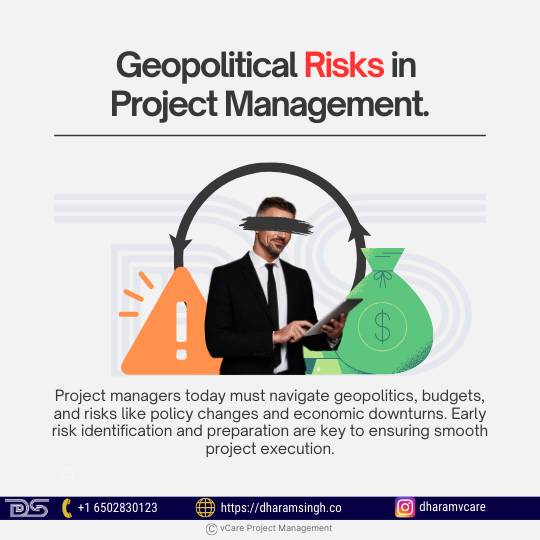
Geopolitical Risks in Project Management
Some instances of geopolitical risks are:
A 2024 Beazley Risk & Resilience research states that 33% of business executives, up from 27% in previous years, said that political risk, particularly political violence, was their primary concern. Similarly, the World Economic Forum’s 2023 Global Risks Report stated that two of the biggest issues confronting companies today are economic instability and regulatory unpredictability.
Factor geopolitics into technology strategy
The factor of geopolitical risk in technology strategy as per the EY-Parthenon stresses the urgent relevance for CEOs to incorporate geopolitical risks into their technology and digital transformation strategies. While CEOs may recognize the importance of technology and digital innovation, they underestimate the impact of geopolitical factors on their operations.
The four main geopolitical risks to be prioritized are:
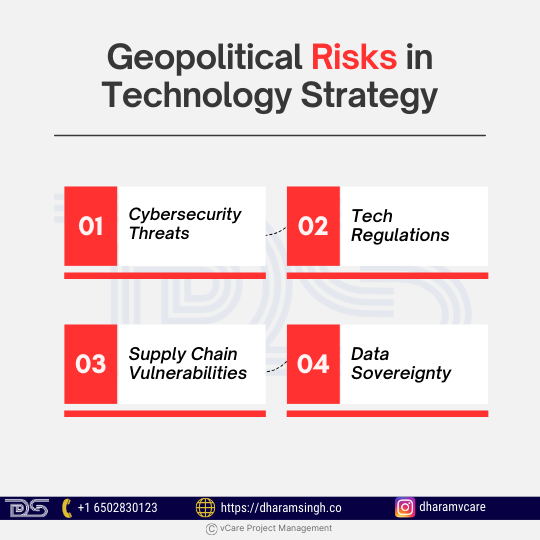
Geopolitical risks are reshaping digital strategies. Learn how leaders can future-proof tech investments with informed risk management.
· Cybersecurity threats: Geopolitically motivated attacks could steal sensitive data and continue to disrupt operations. Firms now have the chance to invest in some strengthening of their cybersecurity controls and employee knowledge to deal with the threats.
· Technological regulations: Divergent rules on technology between countries will heighten complexities in globalization. The relative impact of this divergence on its global presence and localized technology solutions can be used to build greater resilience.
· Supply Chain Vulnerabilities: Geopolitical tensions could disrupt supply chains, especially in cases where a supply chain depends on technology coming from a specific region. This risk can be mitigated by diversifying suppliers and assessing the geopolitical stability of sourcing regions.
· Data Sovereignty Issues: Data protection laws vary from country to country. Hence, it is essential to know those laws and operate within the country’s legal proceedings to avoid any legal complexity and maintain the integrity of the operations.
To effectively handle such risks, it is recommended that the risk management teams should find the solution by:
·Analyze Technology-Specific Geopolitical Risks: Identify and track politically driven risks to current and prospective technologies at all levels: geopolitical, country, regulatory, and societal.
· Assess System Resilience: Collaborate with operations and compliance teams to understand how differing regulatory standards in key markets affect the company’s international presence and determine whether localized technology and data strategies would make it more resilient.
· Engage Leadership: Educate the C-suite and board of directors on geopolitical risks to technology investments, so decisions are made in an informed manner and risk management is effective.
Here are the geopolitical risks which has been explained in details:
1. Political and Economic Instability: Its Impact on Projects
Political and economic volatility can significantly impact project managers, as sudden changes in financial stability, governance, or policy can disrupt project execution, increase costs, and make decision-making unclear. The interconnectedness of the world’s economy makes it crucial for leaders to adjust and plan their strategies accordingly. Examples of political volatility include government instability, policy changes, trade restrictions, and diplomatic disputes.
Economic volatility is caused by trade restrictions, inflation, interest rate changes, and currency movements. According to a recentWorld Bank analysis, financial instability has a direct influence on business investment choices, which has led to an increase in global economic uncertainty over the previous ten years. The Atlanta and Richmond Federal Reserve Banks, in partnership with Duke University, conducted a survey in 2024 that found that about one-third of financial officers had delayed or reduced their investment plans because of the uncertainty surrounding the U.S. presidential election.
How Projects may be directly impacted by such volatility?
- Overspending brought on by inflationary pressures and growing material costs.
- Delays in purchases brought on by trade barriers and currency depreciation.
- Risks to regulatory compliance brought on by abrupt changes in policy.
- Market volatility causes the viability of projects to fluctuate.
2. Regulatory and Compliance Challenges
Project managers find navigating regulatory and compliance complexities increasingly challenging due to evolving regulations across jurisdictions. Consilio’s survey revealed that 60% of legal, risk, and compliance professionals prioritize operational reinventions to manage escalating workloads, primarily because the overwhelming volume of work arises from increasing data complexities and stringent global regulations.
Key challenges in regulatory compliance include:
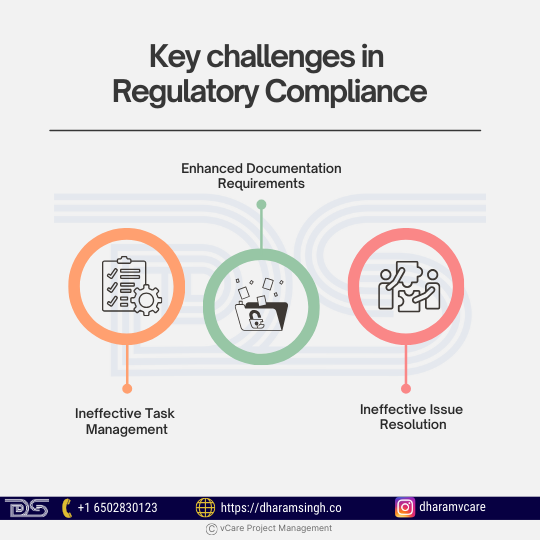
Organizations face increasing pressure to improve compliance coordination, documentation, and issue resolution in today’s regulatory landscape.
- Ineffective Task Management: Due to a lack of departmental visibility and coordination, organizations frequently struggle to ensure the timely execution of compliance-related activities.
- Enhanced Documentation Requirements: Regulators demand strong data management and reporting systems because they require thorough documentation and audit trails.
- Ineffective Issue Resolution: Inadequate departmental communication and prioritization can cause delays in resolving compliance-related concerns.
To effectively manage these complexities, the following strategies can help organizations implement:
Constant Monitoring of Regulatory Changes: Create procedures to keep abreast of changing laws and enforcement patterns, ensuring that teams promptly modify compliance strategies.
- Impact Evaluations of New Rules: Regularly assess how new rules affect current operations and procedures to enable proactive compliance changes.
- Allocating Resources for Compliance-Related Activities: Ensure that you have enough money and staff to support compliance efforts and effectively handle regulatory obstacles.
By using these tactics, project managers can negotiate the complex regulatory landscape more effectively, ensuring that they complete projects successfully and comply with changing requirements.
3. Supply Chain Disruptions and Resource Dependencies
Supply chain disruptions in project management refer to the unforeseen interference with the flow of materials or resources that are usually experienced due to supplier problems, logistics, or other external conditions like natural disasters. Since project management relies so much on specific materials from a very limited pool of suppliers, such supply chain disruptions may unnecessarily prolong the project timeline and increase the cost.
Over 80% of supply chain executives think that issues will persist or worsen shortly, and most have experienced at least one disruption in the past 12 months, according to an Oracle survey. Also, in a study by McKinsey & Company, organizations adopt high-tech planning, execution, and risk management as they accelerate their efforts to diversify and localize their supply networks.
Project managers can be proactive about weaknesses in the supply chain and implement robust plans to ensure that projects are delivered effectively even in uncertain situations.
Tricks for risk mitigation are:
• Disruptions can be caused by political, trade, sanctions conflicts, natural disasters, pandemics, labor shortages, and transportation challenges.
• Mitigating disruption risks involves diversifying suppliers, investing in technology, building flexibility, and strengthening relationships.
4. Digital sovereignty, data security, and cyber security risks
As the digital landscape continues to grow, the corporate community has made cybersecurity, data protection, and digital sovereignty its top concerns. Therefore, protecting sensitive data and maintaining operational integrity becomes crucial in the face of advanced cyberthreats and evolving data privacy laws.
a. Cybersecurity Threats
Artificial intelligence (AI) advancements have contributed to the dramatic rise in cybercrime. According to the World Economic Forum’s Global Cybersecurity Outlook 2025 study, geopolitical tensions have increased the frequency and potency of cyberattacks directed at enterprises and governments. The study highlights the necessity for businesses to adopt a “zero trust” architecture in order to increase resilience against these threats.
b. Data Protection Challenges
According to a global survey commissioned by Yubico, over half of working people have fallen victim to hackers or scams, with 45% reporting compromised personal data. Despite these extremely concerning figures, a large percentage of respondents acknowledged that they reacted to threats rather than taking proactive measures to secure their data in both the personal (45%) and professional (44%). As a result, it is even more crucial for companies to implement strong data protection policies and proactive security measures.
c. Digital Sovereignty Considerations
Digital sovereignty is the ability of a country or organization to control its own digital data, technology, and infrastructure. According to a TNO study paper, maintaining control over one’s economic, social, and democratic future will be based on attaining digital sovereignty in cybersecurity. In order to close gaps in strategic autonomy, the research suggests developing the necessary cybersecurity skills and competences.
Key Strategies for Organizations to overcome these threats:
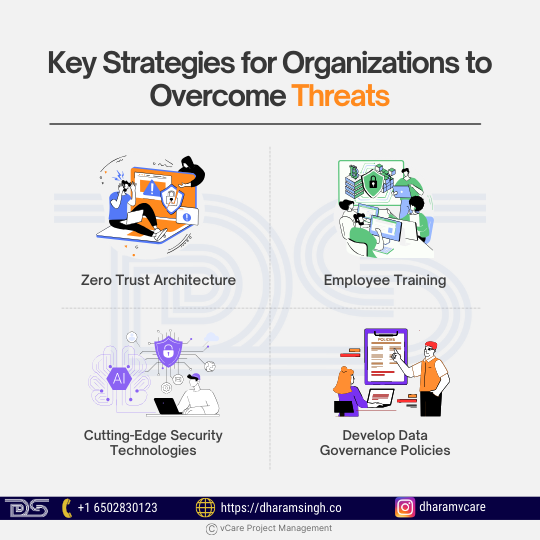
Implement zero trust, data governance, AI security, and employee training to reduce cyber and compliance threats effectively.
· Zero Trust Architecture: Reduce the chance of unwanted access by implementing a security architecture that demands stringent verification for each user and device trying to access resources.
· Employee Training: Conduct regular cybersecurity awareness training to teach staff members how to spot and handle any attacks.
· Cutting-Edge Security Technologies: Use AI-driven security solutions to identify and address threats instantly to improve overall security posture.
· Develop Data Governance Policies: Define data management policies that remain in control over data assets, ensuring compliance with international data protection laws.
By prioritizing cybersecurity, data protection, and digital sovereignty, an organization may reduce the risks of cyberattacks and rule disobedience. In this manner, they would be protecting their operations and reputation in a world that is getting more interconnected by the day.
There are strategic risk mitigation techniques that should be employed in order to overcome uncertainties and ensure long-term success in the many threats that firms face in today’s changing business environment.
Here are some of the major Strategies for Risk Mitigation:

Organizations can manage uncertainty and enhance resilience by adopting key risk mitigation strategies such as environmental scanning and scenario planning.
· Environmental Scanning: As threats can be better confronted early, companies should monitor external factors like market trends, regulatory changes, and technological advances regularly. This would allow them to anticipate challenges and make corresponding adjustments.
· Risk Prioritization: Risk prioritization lets companies use their resources properly, focusing on severe risks first. Analyze hazards based on the feasibility of their happening and their potential impact.
· Scenario Planning: Prepare several scenarios that outline possible future events and consequences. This technique enhances decision-making in uncertain times and helps organizations prepare for a range of circumstances.
· Investment in Technology: Apply risk management tools and advanced analytics to collect current information on any potential threats. Technology may aid in the early spotting and provide data-driven risk mitigation solutions.
· Ongoing Monitoring and Assessment: Establish a structure for ongoing risk management and assessment. Regular assessments ensure that mitigation strategies remain effective and are updated based on emerging trends.
Companies are now increasingly integrating risk management into strategic planning processes for better resilience, as a detailed Deloitte survey reveals. Moreover, the PwC Global Risk Survey reveals that the involvement of board members and business leaders in the risk management process through strategic decision-making ensures that risk insights inform important business decisions and foster a proactive risk culture. Implementing these strategic risk mitigation approaches enables organizations to better navigate uncertainties, safeguard their assets, and achieve their long-term objectives.
Case Studies: Insights from Managing Geopolitical Risks
Geopolitical risks would have a deep impact across different industries: at the strategizing level as well as at the operational level of an organization. Case studies where companies successfully manage geopolitical risks can be very informative about effective strategies. Here are ten examples:
1. Financial Services Firm in Dealing with US-China Tensions
With rising tensions between the United States and China, one of the leading financial services firms in Asia-Pacific took an even more proactive step by engaging with EY-Parthenon to guide them through these complexities. Senior leadership strategy workshops and scenario planning were used to uncover key risks and develop robust strategies for business disruption. This proactive strategy allowed the company to foresee obstacles, modify its operating structure, and protect its commercial interests in the face of geopolitical unpredictability. The firm improved its readiness and obtained a competitive advantage in an uncertain market by incorporating geopolitical risk management into its fundamental strategy. The partnership with EY-Parthenon provided leadership with valuable insights that promoted flexibility and well-informed choices. This success story demonstrates that well-thought-out plans may transform geopolitical concerns into opportunities for development and stability, underscoring the need for proactive risk assessment and strategic foresight in maintaining corporate resilience.
2. Multinational Corporations manage Reputational Risk Amid Geopolitical Conflicts
Geopolitical conflicts, specifically the Israel/Hamas confrontation, have brought yet another wave of reputational challenges to multinational businesses. These groups must operate complex political landscapes by maintaining stakeholder trust. Stakeholder sentiment continuous monitoring is well addressed by Conference Board’s China Centerthrough various data-driven findings. Such a proactive approach can help businesses detect and counter possible reputational risks before they build up. An informed and responsive multinational corporation is better placed to maintain its integrity, safeguard the image of the brand, and prove resilience at a time when global conflicts increasingly affect corporate reputation.
3. Strengthening European enterprise resilience towards geopolitics.
The World Economic Forum report says European companies are acting aggressively to drive resilience amid increasing geopolitical uncertainty. Companies are focusing on agility and preparedness, not missing the opportunity to quickly adapt to change in global dynamics. Strategies include comprehensive risk assessments, robust risk reduction plans, and protective measures such as ring-fencing critical business functions. There is also the rapid response framework established to ensure there is smooth operation continuity. All these proactive steps taken by the European enterprises will not only be protecting their interest but also securing stronger long-term competitive positions as they demonstrate stability and strategic vision in an unstable global environment.
4. International Companies Practice Three-Locus Risk Analysis
According to McKinsey & Company, leading global firms are using a three-locus risk analysis in dealing with geopolitical uncertainty. Through observation of risks along the short-term, mid-term, and long-term horizons, an organization achieves a dynamic and forward-looking perspective that provides for better resilience. Such an approach gives a firm the strength to react effectively and in real-time to a shifting global scenario, make strategic investments, and minimize possible interruptions. A proactive position on risk management will allow firms to protect and strengthen operations with stability, all while seizing on emerging opportunities across geopolitical shifts, thus guaranteeing sustained growth as well as agile performance in ever-changing international business landscapes.
5. Financial Institutions Managing the Geopolitical Risk
Deloitte highlights that geopolitical risk is a threat that financial institutions face highly adversely. During these uncertain global times, companies have to be strong by devising a proper framework for risk management. Undoubtedly, a one size fits all, but preparedness in the form of scenario planning, regulatory compliance, and diversified investments would help correctly position itself amidst unpredictable geopolitical scenarios. Financial services companies can avoid such distractions, protect their assets, and become stable by using agility and information. Forward-looking geopolitical risk management makes sure that institutions are resilient, adaptable, and well-positioned for sustained success in an ever-evolving global economy.
6. Organizations Use Geopolitical Risk as a Source of Strategic Advantage
An Forward-looking companies are turning geopolitical risks into strategic opportunities through a risk analysis approach designed by the Boston Consulting Group. Instead of fearing uncertainty, firms use it to identify the growth and resiliency opportunity of risks assessed. The tool will guide a firm through uncertain geopolitical terrain while perfecting the strategy for greater competitiveness. Proactive management of risks is bound to make the organizations take better decisions, fortify their global positioning, and transform challenges into innovation catalysts. Companies can future-proof their operations, ensure sustainable success, and thrive in the increasingly dynamic global environment through embracing geopolitical risk as a strategic lever.
7. Risk Managers play Key Roles in Geopolitical Strategy
According to WTW, risk managers are now becoming critical geopolitics architects. Applying case studies and scenario-based analysis, they can enable the organisation ahead of the geopolitical shock: prevent, predict, and prepare. Risk managers equipped by proactive approaches in risk management help businesses operate in uncertainty, secure operations, and make even potential threat opportunities. Strategic insights of a risk manager encourage resilience, enabling firms to be flexible and adaptive to unknown external influences within the global political scenario. As businesses begin to realize the value of geopolitical foresight, risk managers assume a crucial position in determining the long-term stability and success, which further establishes their indispensable role in corporate strategy and risk mitigation.
8. European Firms Mitigate Dependency on Critical Inputs
European companies are aggressively de-risking their dependence on critical inputs to avoid the consequences of over-reliance on suppliers from China. Eurosystem central banks surveys show that there is still much exposure, leading businesses to implement de-risking strategies. By diversifying their supply chains and sourcing critical inputs from within the EU, firms are building resilience and reducing vulnerabilities. This proactive shift not only strengthens supply security but also promotes regional economic stability. By giving strategic supplier diversification a high priority, European enterprises are bolstering their resilience, ensuring business continuity, and positioning themselves for long-term success in an increasingly uncertain global trade environment.
9. Pharmaceutical Companies Start Improving their Supply Chain Vulnerabilities
Pharmaceutical companies are now taking some pretty bold strides toward securing and hardening their supply chains with a view of escalating geopolitical risks. Identifying this imperative necessity in terms of an uninterrupted availability of life-saving medicines, firms diversify the production locations while seeking strategic, one-on-one ties. Through such actions, these firms curtail reliance on one single-source vendor and enlarge production capabilities at numerous places across geographies in efforts to gain a greater robustness against eventual stoppages. This proactive approach would ensure that, even in situations of geopolitical instability, all such essential medicines remained accessible. Thus, innovation and collaboration are ways by which pharmaceutical companies safeguard public health, strengthen their commitment to global healthcare security, and achieve supply chain sustainability.
10. ECB Develops Framework to Assess Geopolitical Risks for Banks
The European Central Bank has been pioneering and innovative in strengthening the banking sector against geopolitical risks through designing a comprehensive risk assessment framework. As a response to the unfolding of new global tensions-in this case, changes in sanctions on Russia-this initiative stands ready to prepare banks for any kind of eventualities and ensures the strength of their resilience. The ECB thus equips financial institutions with relevant insights about geopolitical risks that can help them navigate disruptions, ensure stability, and protect their economic integrity. The proactive approach would strengthen the banking sector’s capacity to withstand shocks while reinforcing its adaptability, thereby still garnering continued trust and confidence in Europe’s financial system within an increasingly unpredictable global landscape.
Major highlights from the Case Studies and Lessons from Geopolitical Risk Management are:
- Scenario Planning: This is proactive where the organization prepares and analyzes different geopolitical scenarios and prepares for future risks and appropriately responds to those risks.
- Stakeholder Engagement: Informing and keeping track of the public’s view may make reputation risks manageable.
- Investment in Resilience: This would be resource allocation towards developmental adaptability and response, and will be one of the primary enablers for dealing with geopolitical uncertainties.
- Decisions Based on Data: Utilization of data analytics in strategies increases the ability of an organization to take data-driven decisions, and makes risk management more effective.
These examples give any organization the fundamental strategy in how to manage geopolitical risk and ensure continued success in an unstable world.
Insights and Good practices of Leadership Perspectives and Effective Practices
Effective leadership is the primary key to guiding through the tough times of today’s dynamic and complex project environment. Recent research has brought important insights and good practices that would help enhance the success of projects:

Effective leadership blends adaptability, emotional intelligence, and continuous learning to drive project success in complex environments.
1. Adopt adaptive leadership
The Project Management Institute, in the “Pulse of the Profession” report, highlighted that adaptive leadership is one of the critical cornerstones for success in a dynamic landscape. Such leaders with an open heart for flexibility and change are equipped to effectively respond to uncertainty. In turn, their teams would remain resilient, innovative, and forward-focused amidst a dynamic environment.
2. Promote Effective Communication
Effective communication forms the heart of good project management. According to a Journal of Organizational Excellence, communicating project managers avoid closed and inconsistent forms of communication, which tend to create stronger collaboration and improved output in projects. Clarity, transparency, and engagement empower teams, ensuring alignment, efficiency, and success in every phase of a project.
3. Use of Technological Tools
Embracing technological tools changes the dynamics of project management by streamlining how things are done and improving collaboration. A global leader in crane and lifting solutions, Palfinger, used Smartsheet to align different departments and streamline workflows-that significantly improved its project management capabilities-becoming an enormous success story that showcases how digital tools can facilitate smooth coordination and operational excellence.
4. Continuously Learn
Lifelong learning is the road to leadership greatness. According to the 2021 Annual Leadership Development Survey Report, continuous professional development is considered a critical method of staying in front of rising challenges. Therefore, through continuing education and the best practices embraced by leaders, they improve adaptability, develop their skills sharper, and ultimately drive sustainable success in the midst of constant evolution.
5. Emotional Intelligence
Effective leadership is based on emotional intelligence. Its critical importance in promoting positive team dynamics and project performance is highlighted by research. A resilient and high-performing work environment that flourishes in the face of adversity is created by leaders who comprehend and control emotions, both their own and those of their team.
Conclusion: Steering Projects Through Geopolitical Risks for Success
Geopolitical risks are highly complex and broad in project management and include political and economic uncertainty, legal problems, a disturbed supply chain, and cyberattack issues, among many others. However, under good leadership with specific strategic ways to mitigate geopolitical risks, opportunities exist to harness those risks toward better resilience and growth.
This means a proactive understanding and definition of geopolitical risks within the project landscape. Leaders need to recognize the effects of political and economic volatility, changing investment climates and disrupted project timelines. Regulatory and compliance complexities require due diligence and strict adherence to shifting legal frameworks across jurisdictions. Dealing with supply chain disruptions requires diversification, reshoring strategies, and stronger partnerships to ensure resource stability.
In this age of cybersecurity and digital sovereignty, data protection and security of digital infrastructures have become the highest priorities. Organizations can protect operations through advanced security protocols, regulatory-compliant frameworks, and cross-border data-sharing agreements. Case studies analyzed in this discussion indicate that companies better prepared to address geopolitical uncertainties include those that are proactive in assessing risk, investing in resilience, and developing contingency plans.
Effective leadership controls such risks. An effective leader inspires adaptability, facilitates clear communication, and makes full use of technology for improving project performance. Thus, a continuous learner and an emotionally intelligent leader could improve his/her team’s adaptability in overcoming unforeseen threats.
The way out is through foresight, flexibility, and ingenuity. Companies should incorporate geopolitical risk management into their strategic planning, the processes behind data-driven decisions, and global cooperation. In that respect, it can help organizations not only manage risks but deliver a competitive advantage in this volatile world. Project leaders may utilize the right strategies to create resilient and future-proof projects that thrive despite uncertainty.
#GeopoliticalRisks #ProjectManagement #StrategicPlanning #RiskMitigation #Leadership #DigitalSovereignty #Cybersecurity #Compliance #SupplyChainDisruptions #vCareProjectManagement

















































Recent Comments